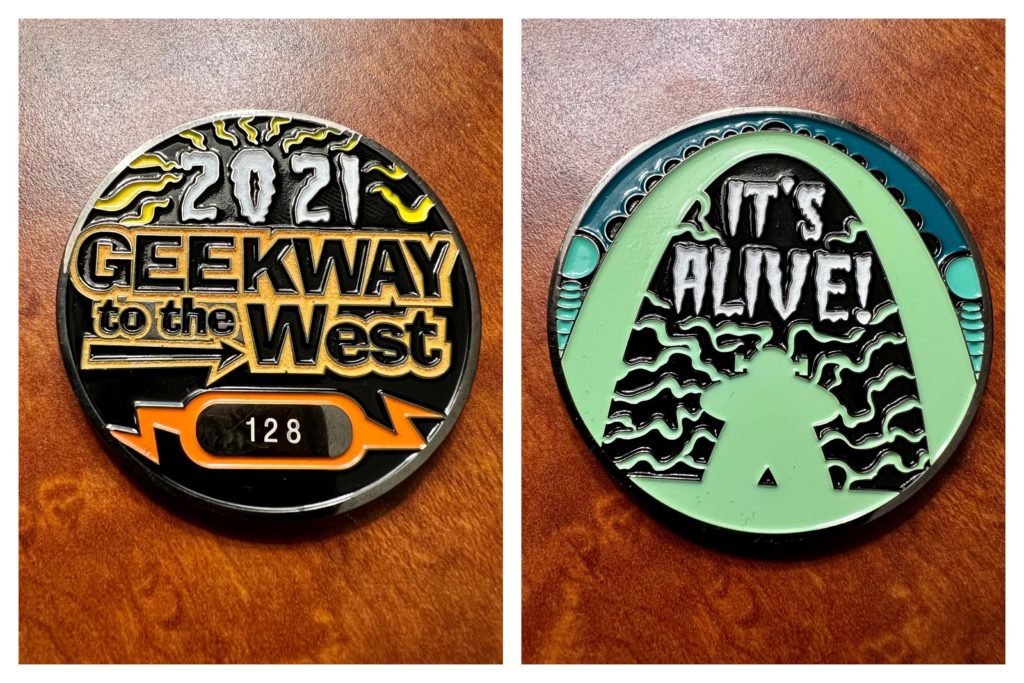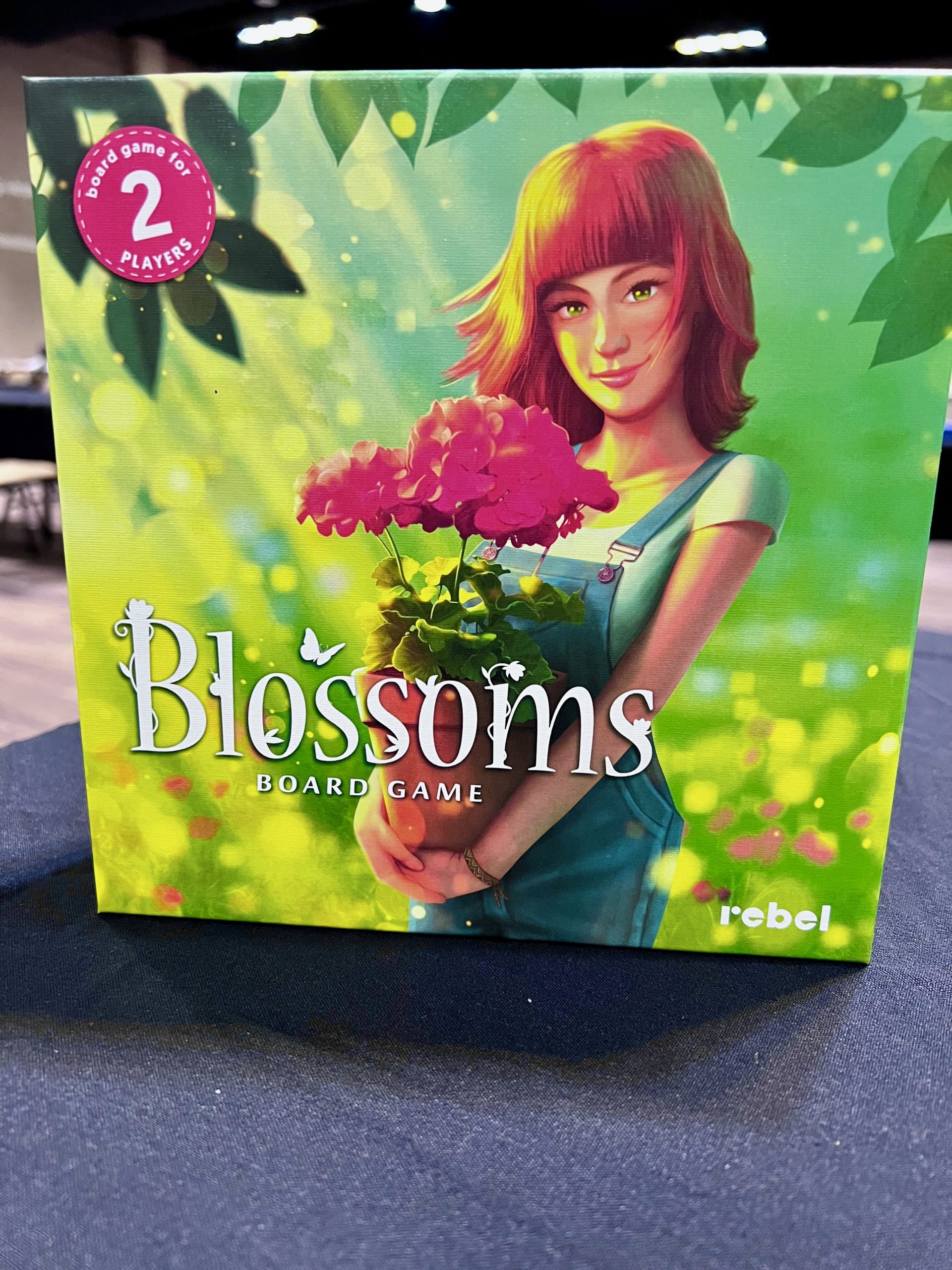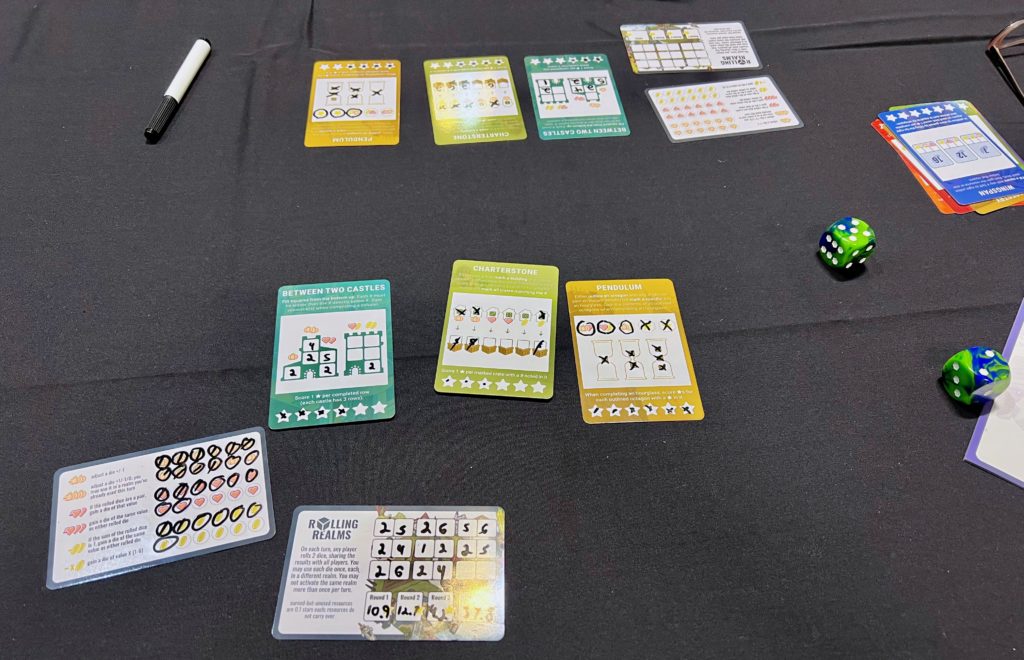Category: Games
My wife and I watch Cracking the Cryptic, a YouTube channel that solves sudoku and talks through the logic. I’ve seen similar with the NYT Crossword, so I decided to give it a shot. Pretty fun (though I’m terrified of mispronunciations). Here’s today’s puzzle:
Geekway 2021 Wrapup

So, Geekway 2021.
We played 25 games, only repeating one, and all new to us.
It was the first large event I’ve been to since March 2020. Everyone was required to be vaccinated and wear masks when playing games, so I felt reasonably comfortable.
The swag was pretty great — a challenge coin that glows in the dark, a set of 3 custom anodized D6 in a metal case, and a really awesome board game bag.
We didn’t win any door prizes, but my wife and I did each win a play-and-win game. We got Blossoms and Holi, both of which we enjoyed quite a bit.
Here’s a list of what we played:
Day 1
- Renature
- Blossoms
- Santa Monica
Day 2
- Rolling Realms
- Juicy Fruits
- Meadow (@3)
- Watergate
- The Castles of Tuscany (@4)
- Dinner in Paris
- Islands in the Mist
- Holi: Festival of Colors
- Herbaceous
- Spirits of the Forest
Day 3
- Maglev Metro
- Dragon Land
- Dice Miner
- Meadow (again)
- Tapestry
- Cubitos
- Imperial Settlers Roll & Write
- Parks
Day 4
- Pendulum
- Beez
- Everdell
- Villagers
Geekway 2021: Day 4, Thursday

See previous reports here: Day 1 | Day 2 | Day 3
The final day of Geekway is usually a Sunday morning, and usually it’s only games from the library, not play-and-win, because the organizers are busy making sure the play-and-win games have all their components in anticipation of the giveaway. But this year, owing to the semi-shortened schedule, they decided to allow play-and-win checkouts until 2 p.m., with the drawing and game pickup at 5. So, we got in a couple play-and-win games in the morning, and then a couple from the library while we waited for the convention to wrap up.Pendulum
 First up, as our apparently traditional heavy morning game, was Pendulum. Another one by Stonemaier games, and it was weird. Interesting though.
The conceit here is that this is a real-time game. Players aren’t taking turns, instead you’re moving workers around on a board, but the movement rules are governed by sand timers which get flipped throughout the game. Occasionally you stop and have a round that’s out of that flow, but the majority of the gameplay is supposed to be simultaneous.
There are three timers: 45 seconds, 2 mintues and 3 minutes in different areas of the board. Essentially, these “lock” those sections of the board when the sand is running. You can stage a worker in an area before the timer flips, then once it flips, take the relevant action. But even after you’ve taken the action, that worker is locked up until the timer flips again. There are a few other rules regarding how many workers can be in a space, etc. but the timers thing is really what sets this game apart.
For example, if you put a worker in the 3-minute square at the beginning of the round, the timer will flip and you can take that action. But you won’t get that worker back for 3 minutes. If you’d put the worker in the 45-second spot before the timers flipped, it would be free to move somewhere else 45 seconds later. In general, the 3-minute actions are more powerful than the 2-minute actions, which are more powerful than the 45-second actions. But they’re all different and what you need at any given time may vary.
We didn’t do any of that.
The game includes instructions for playing through a round un-timed, and recommends you take at least the first round that way, if not your first game. So that’s what we did. There’s a card showing the order of flipping the timers, which you still do, but you take as long as you want in between flipping them. The card is structured so that the timers all still flip about when they normally would, in relation to each other, so you get a sense of what a real game would be, without the time pressure.
At the end of each round — after the three-minute timer has flipped three times (including to start the round) — there’s a “council” phase, where privilege (Pendulum’s way of settling disputes when two players want to do the same thing at the same time but can’t) is determined for the next round and rewards are claimed. There are four rounds.
It’s an asymmetric game in that each player is playing a different character. There are three types of victory points, and to win you need to earn a certain number of each type (plus a “legendary achievement”, which you need to earn once at any time during the game). But each player needs to earn a different amount of the different types — one player needs an equal amount of each, other players need more of one kind or another. This is balanced by the amounts of income of different types the player earns for different actions, as well as the special abilities (in the form of cards played any time during the round, and potentially refreshed to play again).
First up, as our apparently traditional heavy morning game, was Pendulum. Another one by Stonemaier games, and it was weird. Interesting though.
The conceit here is that this is a real-time game. Players aren’t taking turns, instead you’re moving workers around on a board, but the movement rules are governed by sand timers which get flipped throughout the game. Occasionally you stop and have a round that’s out of that flow, but the majority of the gameplay is supposed to be simultaneous.
There are three timers: 45 seconds, 2 mintues and 3 minutes in different areas of the board. Essentially, these “lock” those sections of the board when the sand is running. You can stage a worker in an area before the timer flips, then once it flips, take the relevant action. But even after you’ve taken the action, that worker is locked up until the timer flips again. There are a few other rules regarding how many workers can be in a space, etc. but the timers thing is really what sets this game apart.
For example, if you put a worker in the 3-minute square at the beginning of the round, the timer will flip and you can take that action. But you won’t get that worker back for 3 minutes. If you’d put the worker in the 45-second spot before the timers flipped, it would be free to move somewhere else 45 seconds later. In general, the 3-minute actions are more powerful than the 2-minute actions, which are more powerful than the 45-second actions. But they’re all different and what you need at any given time may vary.
We didn’t do any of that.
The game includes instructions for playing through a round un-timed, and recommends you take at least the first round that way, if not your first game. So that’s what we did. There’s a card showing the order of flipping the timers, which you still do, but you take as long as you want in between flipping them. The card is structured so that the timers all still flip about when they normally would, in relation to each other, so you get a sense of what a real game would be, without the time pressure.
At the end of each round — after the three-minute timer has flipped three times (including to start the round) — there’s a “council” phase, where privilege (Pendulum’s way of settling disputes when two players want to do the same thing at the same time but can’t) is determined for the next round and rewards are claimed. There are four rounds.
It’s an asymmetric game in that each player is playing a different character. There are three types of victory points, and to win you need to earn a certain number of each type (plus a “legendary achievement”, which you need to earn once at any time during the game). But each player needs to earn a different amount of the different types — one player needs an equal amount of each, other players need more of one kind or another. This is balanced by the amounts of income of different types the player earns for different actions, as well as the special abilities (in the form of cards played any time during the round, and potentially refreshed to play again).
 If you think that’s a lot…well, it’s a lot. It makes more sense once you’re doing it, but at no point during the first game did I feel like I had a handle on an overall strategy or how I was doing. There’s just a lot happening, and we weren’t even playing a timed game.
The components are just fine. Plastic colored cubes in different colors, tiles for council votes, workers in two sizes, player and victory point markers. Nothing outstanding. The three sand timers are in colors to match their parts of the board.
The art can be confusing at times. Moving the resource cubes and victory-point markers around on and off the player board can be clumsy, which would be a pretty big hindrance in a timed game.
I get what the fuss is — the idea of simultaneous, real-time play is neat. I’m glad I got to try it.
If you think that’s a lot…well, it’s a lot. It makes more sense once you’re doing it, but at no point during the first game did I feel like I had a handle on an overall strategy or how I was doing. There’s just a lot happening, and we weren’t even playing a timed game.
The components are just fine. Plastic colored cubes in different colors, tiles for council votes, workers in two sizes, player and victory point markers. Nothing outstanding. The three sand timers are in colors to match their parts of the board.
The art can be confusing at times. Moving the resource cubes and victory-point markers around on and off the player board can be clumsy, which would be a pretty big hindrance in a timed game.
I get what the fuss is — the idea of simultaneous, real-time play is neat. I’m glad I got to try it.
Beez
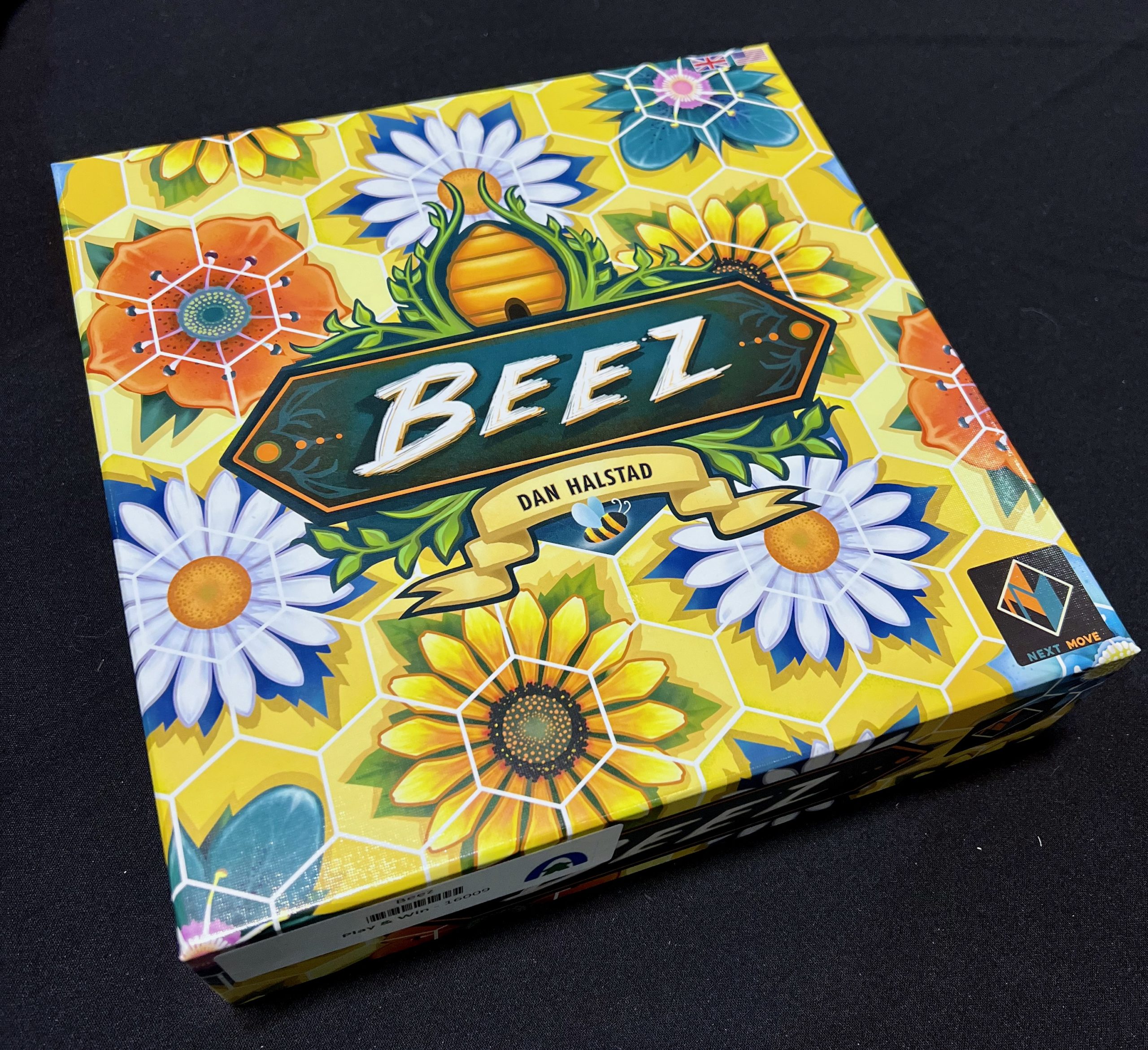 Beez was a good followup. It was our last play-and-win game.
In Beez, you lay out a hexagonal field of flowers with different varieties of nectar, and you are a bee planning a route to collect that nectar and place it in your hive. There are a few community goals, and a couple private goals. These are related to how much and what type of nectar you collect, as well as how you choose to arrange them in your hive.
In Beez, your bee moves according to a particular set of rules — you can never move straight ahead. Your bee is sitting on a hexagonal hive, the same shape as the spaces on the board. You can never move directly forward. You can move either one or five hexes toward one of the front angled directions. You can move either two or four hexes toward one of the rear angled directions. Or you can move three hexes directly backward. In all cases, you choose your move, then — importantly — turn your bee to face that direction and move that number of spaces.
If the space you landed on is adjacent to some nectar, you can pick it up and put it on your board (there’s a bonus for landing in the center of a flower with some nectar, as well). You can only put it into a spot in your hive that matches the length of move you just took. (This relates to the “how you arrange them in your hive” goals, so you can’t just put them anywhere).
Beez was a good followup. It was our last play-and-win game.
In Beez, you lay out a hexagonal field of flowers with different varieties of nectar, and you are a bee planning a route to collect that nectar and place it in your hive. There are a few community goals, and a couple private goals. These are related to how much and what type of nectar you collect, as well as how you choose to arrange them in your hive.
In Beez, your bee moves according to a particular set of rules — you can never move straight ahead. Your bee is sitting on a hexagonal hive, the same shape as the spaces on the board. You can never move directly forward. You can move either one or five hexes toward one of the front angled directions. You can move either two or four hexes toward one of the rear angled directions. Or you can move three hexes directly backward. In all cases, you choose your move, then — importantly — turn your bee to face that direction and move that number of spaces.
If the space you landed on is adjacent to some nectar, you can pick it up and put it on your board (there’s a bonus for landing in the center of a flower with some nectar, as well). You can only put it into a spot in your hive that matches the length of move you just took. (This relates to the “how you arrange them in your hive” goals, so you can’t just put them anywhere).
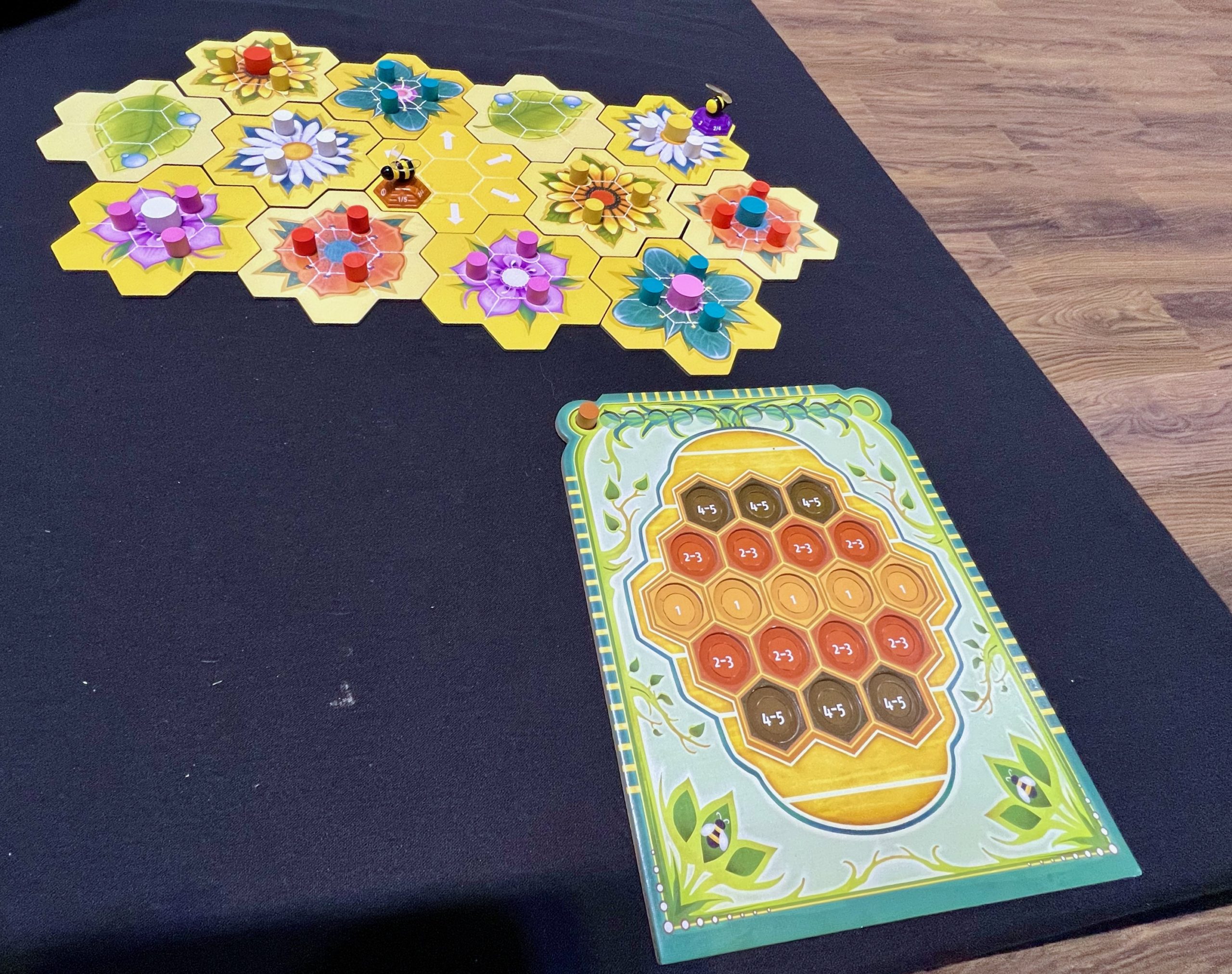 The components of this game are a delight, especially the adorable bees. The color palette is interesting and appropriate as well. The beehive player boards have indentations for the nectar pieces, to ensure they stay where you put them.
This one is easy to pick up, and planning out a route is, at least for my brain, more challenging than I expected. It does seem that, given the arrangement of the nectar is mostly knowncen and the movement capabilities are definitely known, you should be able to plan an optimal route. But the goal cards and arrangement of the flower colors will be different so that could be enough randomness. Additionally you aren’t allowed to land on another bee, so the more players in the game, the more likely that would come into play too.
The components of this game are a delight, especially the adorable bees. The color palette is interesting and appropriate as well. The beehive player boards have indentations for the nectar pieces, to ensure they stay where you put them.
This one is easy to pick up, and planning out a route is, at least for my brain, more challenging than I expected. It does seem that, given the arrangement of the nectar is mostly knowncen and the movement capabilities are definitely known, you should be able to plan an optimal route. But the goal cards and arrangement of the flower colors will be different so that could be enough randomness. Additionally you aren’t allowed to land on another bee, so the more players in the game, the more likely that would come into play too.
Everdell
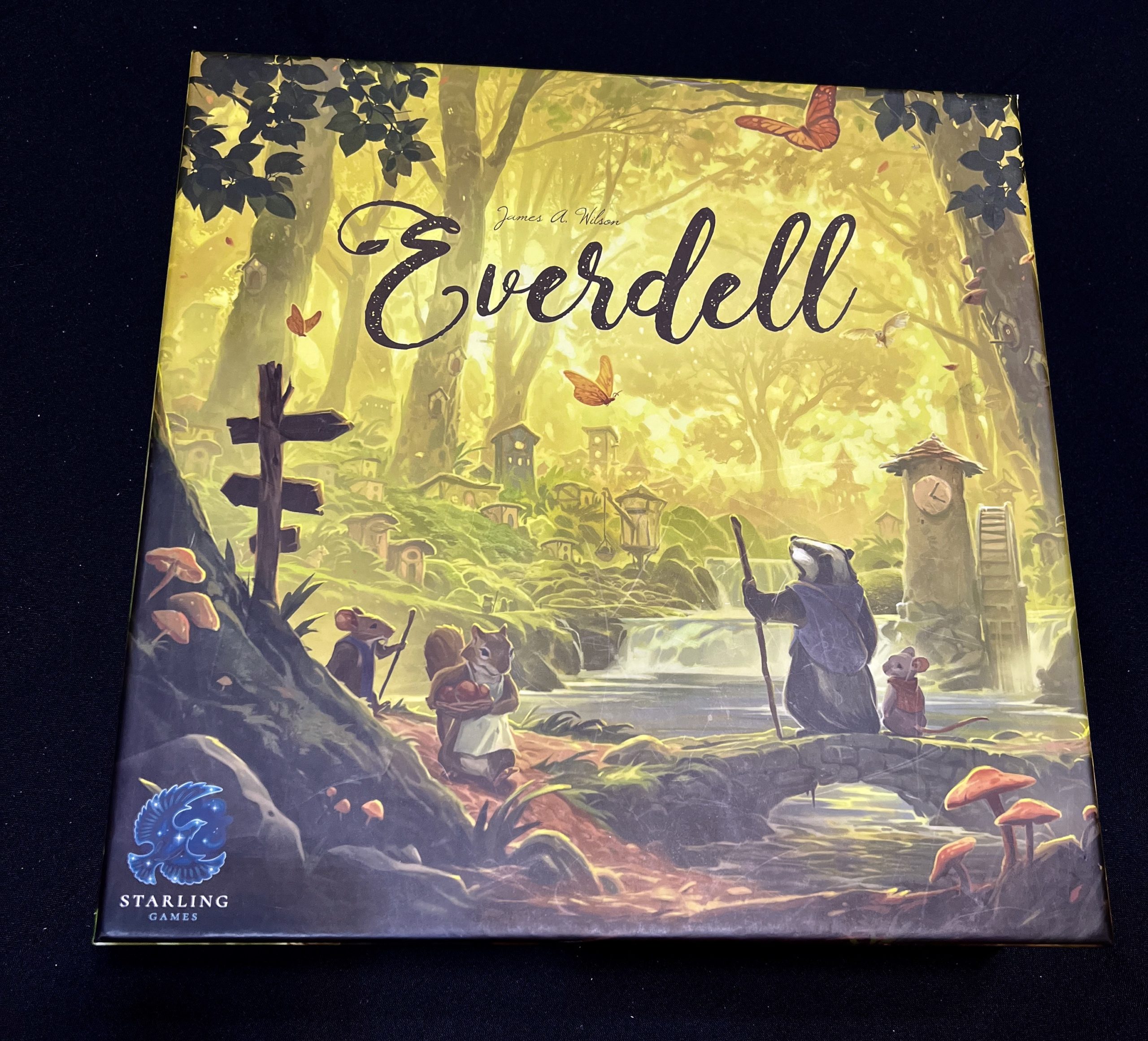 I got Everdell out of the library to play because I recognized the name, though I couldn’t tell you from where. I didn’t realize it’s ranked 28 overall on Board Game Geek. I’ve only played a couple of games ranked higher.
Everdell is a fantasy worker-placement tableau-building game where you’re building a city in the forest over a year’s worth of seasons. Each season you send out your workers to gather resources or give you abilities or victory points and play cards to build buildings or bring residents to your city.
There’s a small bit of engine-building, as some cards let you build/destroy/modify other cards in interesting ways. Once you’ve deployed all your workers and spent all your resources building cards, you “prepare for the next season” by recalling all your workers, gaining a few more, and another action depending on the season.
One interesting thing, similar to Tapestry, is that players’ progress throughout the game isn’t synced in any way — one player can prepare for the next season while another player is still playing in the previous one.
I got Everdell out of the library to play because I recognized the name, though I couldn’t tell you from where. I didn’t realize it’s ranked 28 overall on Board Game Geek. I’ve only played a couple of games ranked higher.
Everdell is a fantasy worker-placement tableau-building game where you’re building a city in the forest over a year’s worth of seasons. Each season you send out your workers to gather resources or give you abilities or victory points and play cards to build buildings or bring residents to your city.
There’s a small bit of engine-building, as some cards let you build/destroy/modify other cards in interesting ways. Once you’ve deployed all your workers and spent all your resources building cards, you “prepare for the next season” by recalling all your workers, gaining a few more, and another action depending on the season.
One interesting thing, similar to Tapestry, is that players’ progress throughout the game isn’t synced in any way — one player can prepare for the next season while another player is still playing in the previous one.
 This one is just lovely to look at. The board and art are nice. There’s a giant 3D tree centerpiece that is (ok, minimally) functional. The worker tokens are animal shapes. The resource tokens are nice — the wood aren’t too interesting, but the stones are pleasingly smooth, the amber is very gemmy and the berries are bright pink and some kind of rubbery plastic that was unexpected. The card art, text and mechanics are interesting.
All in all, a very nice game.
This one is just lovely to look at. The board and art are nice. There’s a giant 3D tree centerpiece that is (ok, minimally) functional. The worker tokens are animal shapes. The resource tokens are nice — the wood aren’t too interesting, but the stones are pleasingly smooth, the amber is very gemmy and the berries are bright pink and some kind of rubbery plastic that was unexpected. The card art, text and mechanics are interesting.
All in all, a very nice game.
Villagers
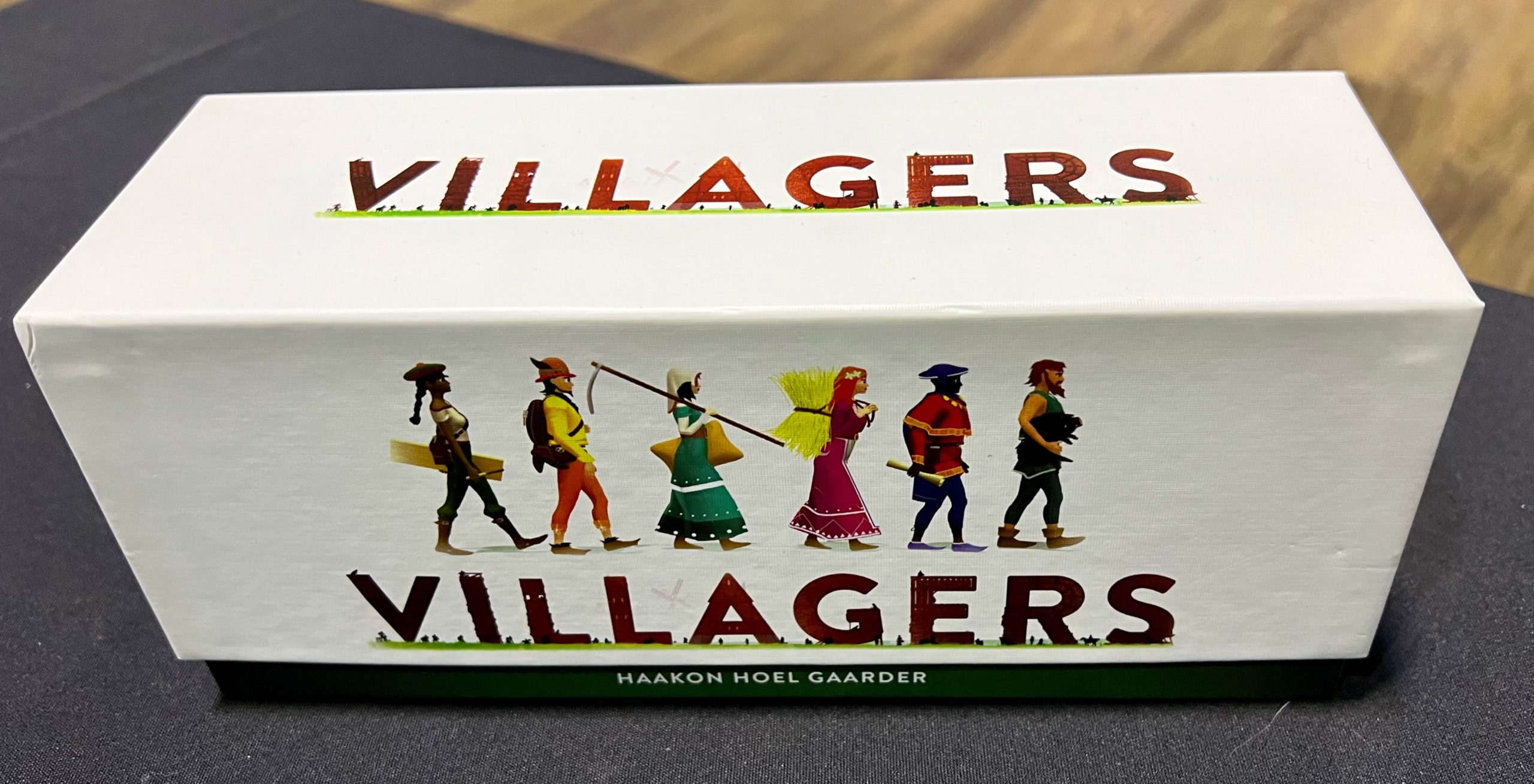 And the final game of Geekway 2021, Villagers.
Villagers is a card-drafting set-collection game where you’re playing the founder of a village and inviting travelers from the road to join your village. You’re hoping to invite villagers whose skills complement each other.
There’s a drafting round where players choose from a set of face up cards (representing travelers on the road) or drawing blindly from the face-down ones. Then there’s a round where you play cards into your village.
The cards you play might need unlocking (for example a vintner needs to be unlocked by a cooper, because a vintner would need barrels). How this works depends whether you or an opponent (or not) has the unlocking card in their village. And some cards just require a prerequisite villager to already be in your village (for example the vintner needs a graper). There are resource chains you can build up, and the more you build them up the more points they’re worth.
The number of cards you can draft and play in a round is also governed by the villagers you have, so it can be a balance between getting points and increasing your capabilities. There are a couple scoring rounds once a certain number of cards have been drafted. And that’s about it.
The art style here is nice. A bit minimalistic, but it appealed to me. The groups and production chains and locked/locking cards generally make sense. There’s a nice variety of cards and scoring opportunities as well. I enjoyed this one.
Read Day 1 | Day 2 | Day 3 | Wrapup
And the final game of Geekway 2021, Villagers.
Villagers is a card-drafting set-collection game where you’re playing the founder of a village and inviting travelers from the road to join your village. You’re hoping to invite villagers whose skills complement each other.
There’s a drafting round where players choose from a set of face up cards (representing travelers on the road) or drawing blindly from the face-down ones. Then there’s a round where you play cards into your village.
The cards you play might need unlocking (for example a vintner needs to be unlocked by a cooper, because a vintner would need barrels). How this works depends whether you or an opponent (or not) has the unlocking card in their village. And some cards just require a prerequisite villager to already be in your village (for example the vintner needs a graper). There are resource chains you can build up, and the more you build them up the more points they’re worth.
The number of cards you can draft and play in a round is also governed by the villagers you have, so it can be a balance between getting points and increasing your capabilities. There are a couple scoring rounds once a certain number of cards have been drafted. And that’s about it.
The art style here is nice. A bit minimalistic, but it appealed to me. The groups and production chains and locked/locking cards generally make sense. There’s a nice variety of cards and scoring opportunities as well. I enjoyed this one.
Read Day 1 | Day 2 | Day 3 | Wrapup Geekway 2021: Day 3, Wednesday
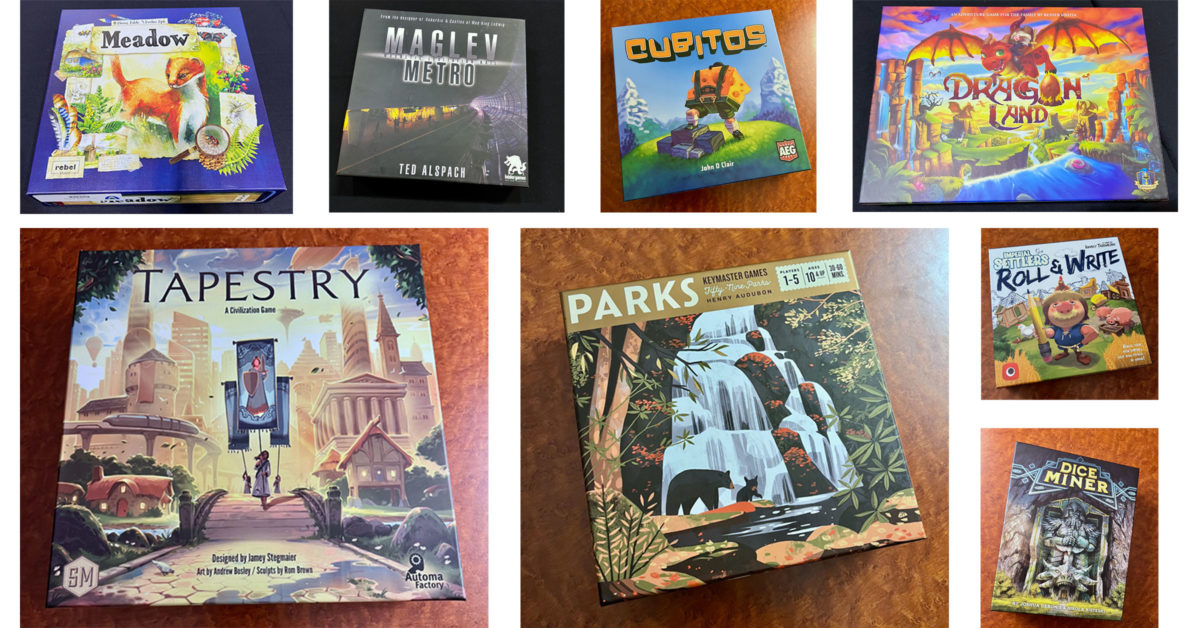
See previous reports here: Day 1 | Day 2
On Wednesday we played eight games, including one from the prior day (have a guess). Two of them were on my “want to play” list for quite a while.
Maglev Metro

We started off with Maglev Metro. I had high hopes for this one — the theme looked interesting and the art too. Turned out to be a little complicated, especially as the first game of the day.
The game has a double-sided board, where you can build a train network either in New York City or Berlin. The game recommended NYC for the first play, so that’s what we did. The idea is to pick up passengers in different categories and deliver them to the stations where they’re trying to go, but first you have to build the stations and routes to them.
Your abilities are configurable, by which I mean you have a player board listing a bunch of attributes about your turn, like number of actions you have per turn, how many tiles of track you can lay in an action, how far you can move, how many passengers you can pick up or carry or drop off in one action, and so on.
These attributes are filled in with passengers that you drop off at the correct stations, so when you start, your abilities are limited and as you progress you start to be able to do more and more on each turn (you start out with a handful of passengers to begin with). Most of the attribute slots are color-coded, so passengers of a specific type can only go in specific spots on your board.
The interesting aspect is that you can spend an action to reconfigure your attributes (and how much you’re allowed to reconfigure is itself an attribute). It reminded me a bit of video games or RPGs where you can allot a pool of points to attributes to configure your character.
We had a bit of rule confusion about the beginning of the game (e.g. what counts as a station you can build to and visit at the beginning), but once we resolved that things went ok.

I really liked the build quality of this game. The board was substantial, and the passengers were pleasingly-colored. I liked the contrast between the commuter passengers in their pastel colors and the robots in their gold, silver and bronze. Your routes are built with lines on plastic tiles so they’re able to overlap, and there are curves of two different sizes so you can overlap curves that don’t hide each other. The trains are interesting, metal and translucent plastic, and the passengers fit neatly inside.
I imagine this would be great with more players, seeing the routes developing over the board and overlapping and such. We mainly played on opposite sides of the board, not competing directly until more toward the end of the game.
I liked the concept of this game, and the art. I thought the execution was a little off. Not just the rules confusion we had, but this also feels like a game that really punishes bad decisions or even just bad luck early on in the game. I think playing more games would help this — once you know how those early bad decisions might affect you, you’d know to avoid them. But for a first-time play, it can be rough. I’d play it again, and I bet it’d be better.
Dragon Land

Next up was Dragon Land, a re-release and minor update of a game by the same name from 2002. You play a team of three characters (abstract wooden figures that look vaguely like chess pieces), one each in three different colors, and hop around through Dragon Land trying to reach volcanoes to collect sets of gems and dragon eggs. Each of your characters also needs to find and collect a ring before the game is over, in order to score their color of gem. Along the way there are also tokens with special powers and even dragons you can hitch a ride on from volcano to volcano as a shortcut.
And that’s about it, really. You roll two dice, use one for one of your three characters and one for a different character. You score based on the sets of gems and eggs you collect (diamonds are wild, and can be used to replace any other gem). There’s just enough depth in planning out your moves to get the gems you need before the other player can, or stealing the dragon from them to take shortcuts. But definitely a game kids would be able to enjoy too.
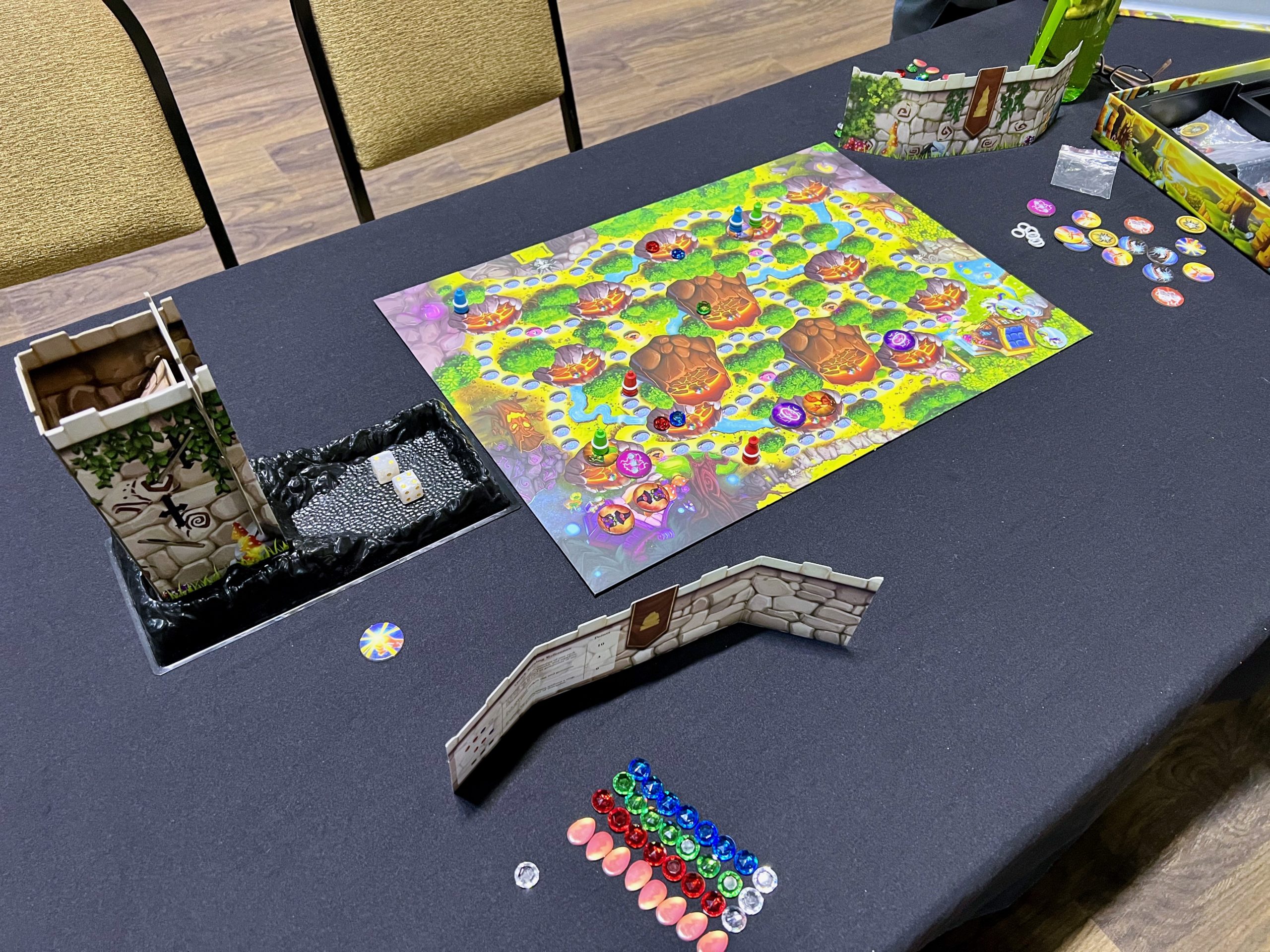
The game looks great, from the art on the board to the colorful gems and tokens to the castle-themed player screens to the dice tower. The one minor issue is that the paths and where you can access the volcanoes aren’t quite as clearly defined as I’d like. The dice themselves are nice as well. The manual kept referring to them as “destiny cubes” which I thought was just the game trying to be clever, but after our third-in-a-row combination of 2-4, I had a closer look and realized they weren’t standard, 1-6 dice.
This is an easy game to pick up, but with a deceptive amount of depth. It would be a good way to introduce someone, especially kids, to more advanced games.
Dice Miner

Dice Miner is a great new game, especially if you like to roll tons of dice.
You play dwarves mining mountains for dice, and there are lots of dice. The game comes with 60. Each round you fill up the mountain, then take turns choosing dice, usually from the top. Different colored dice do different things for scoring, and one face of each type is a mug of beer. You can share a beer, if you have one — you roll the beer die over to your opponent, but then you get to choose two dice from the mountain and you can take from the side (allowing dice on top to slide down and fill in the spots below). After all the dice are gone, you can use some of them to re-roll others, and then there’s a scoring round. You do this three times.
This game plays pretty quick and there’s plenty of player interaction. It’s nice, because to gain the share a beer benefit of choosing two dice, you have to give up a die to the opponent, often benefiting them rather than hurting them. The dice sliding down mechanic is nice too. There’s plenty of replayability, not just in the randomness of the dice, but you also select a character at the beginning of the game which provides a couple ongoing benefits.
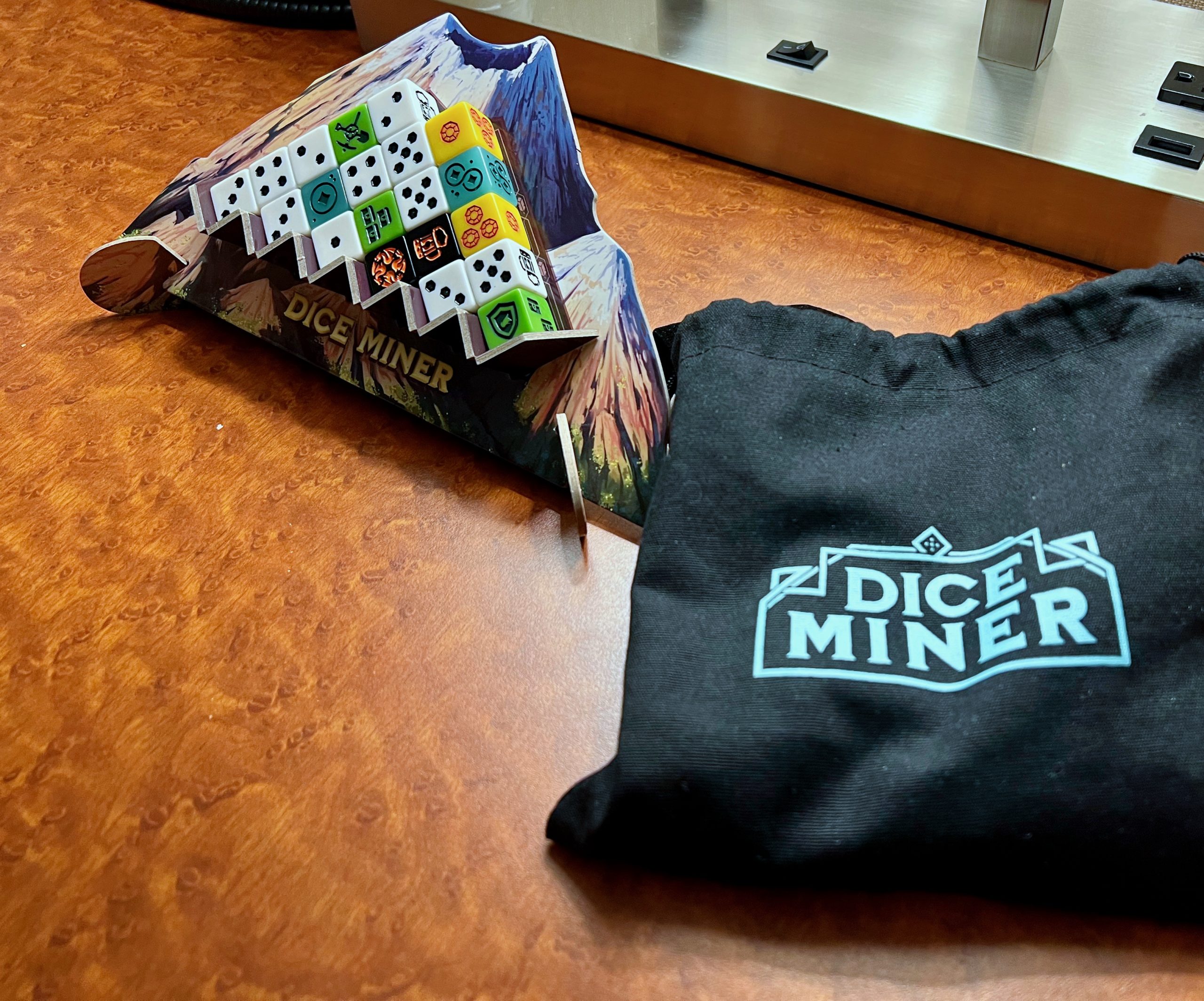
The components are great. The mountain works well and is way less fiddly to fill than I thought it would be. The dice are nice to look at and the art is interesting. We did have a minor rules confusion — you’re supposed to reroll all the dice you’ve collected in between rounds, and we just missed that step the first game we played. But it was quick enough we just played again with the correct rule, and it was much better.
I really enjoyed this one. It worked well at two players, and I think would be just as good at three or four. It’s not a heavy game by any means, but there’s plenty of strategy and important choices to make.
Meadow
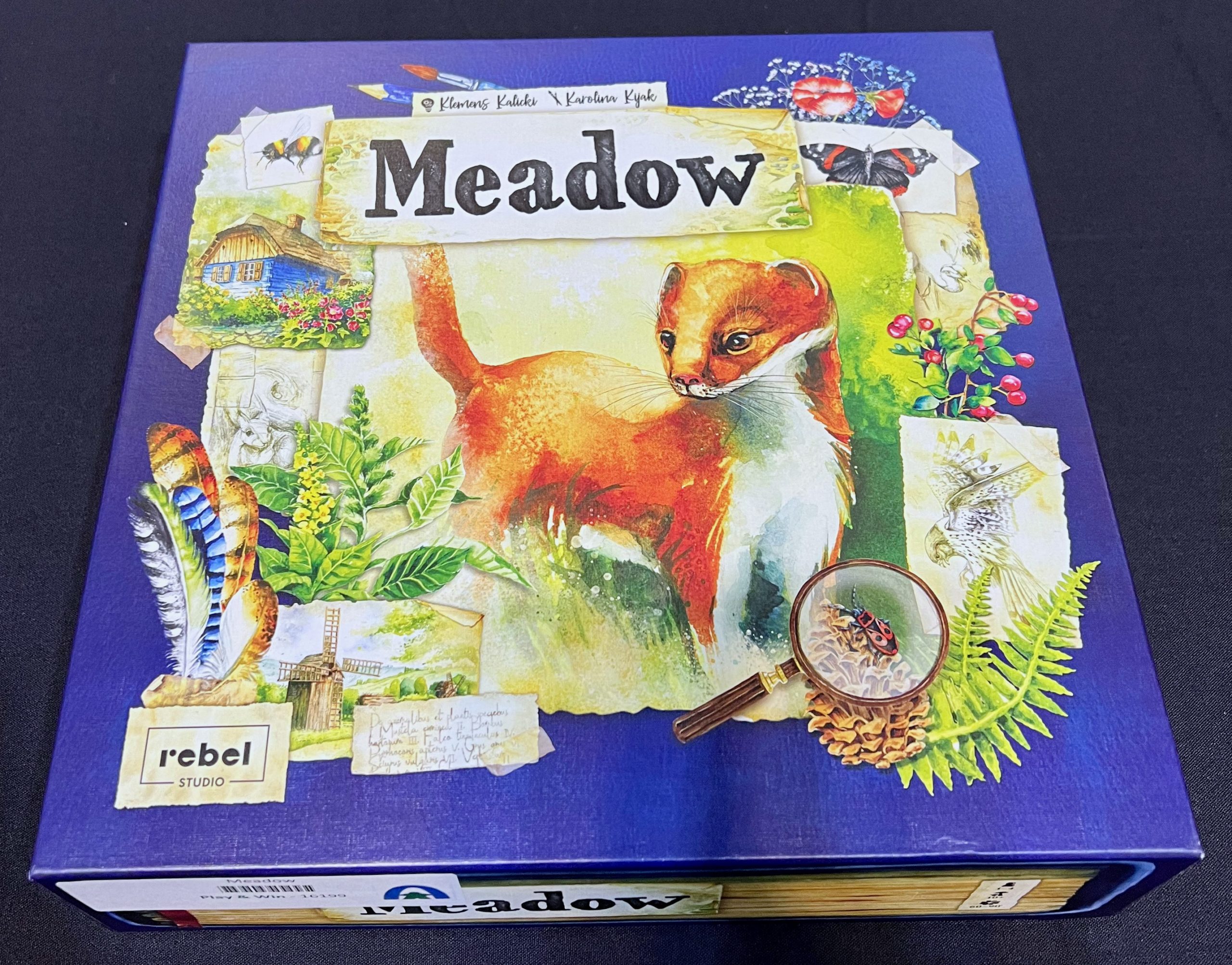
We played Meadow again. See my Day 2 post for its review.
Tapestry

Finally got a chance to play Tapestry. I’d seen this when it came out, and simultaneously knew it looked interesting and that it’d probably be a while before I got to play. It was designed by St. Louis’ own Jamey Stegmaier. It’s…big.
In Tapestry, you’re building a civilization from nothing all the way to AI Singularity and space exploration. You advance on four tracks: Science, Technology, Exploration and Military to, well, explore new regions and conquer them, as well as to gain new knowledge and invent stuff. Each player has a basic type of civilization, like Architects or Leaders, which provides some benefit. Each “round”, you play a new card to your tapestry to tell the story of your civilization and either provide an immediate effect or one that lasts throughout the turn.
I’m not going to explain all the rules here, because as I said, it’s a pretty complex game. You’ve got area majority, tile laying, hand management, tech trees, card drafting and upgrading, income. It’s all here. One interesting aspect is that players’ turns aren’t necessarily symmetrical, in the sense that choosing to spend income differently can allow some players to take more or fewer turns than others.

There’s a lot to this one. A couple different decks of cards, a couple different types of tiles, four tracks around the outside where you’re playing most of the time, four types of income, four types of building minis, three custom dice, player boards, and a whole bunch of custom specialized fully-painted building minis.
It’s an impressive table presence, and the special building minis are particularly great, even if they’re a bit hard to tell apart. The custom dice and income buildings are nice too.
One minor issue was encountering symbols that weren’t obvious and having to track them down. Wasn’t a big deal, just a minor annoyance several times in the middle of the game — and once you play through a couple times I imagine you learn them anyway.
The amount of options on a turn felt varied but not overwhelming. I liked the variety. I’d be concerned about length, but I think this would be fun with three or four players, just to see more variety in cards, strategies, etc.
Cubitos
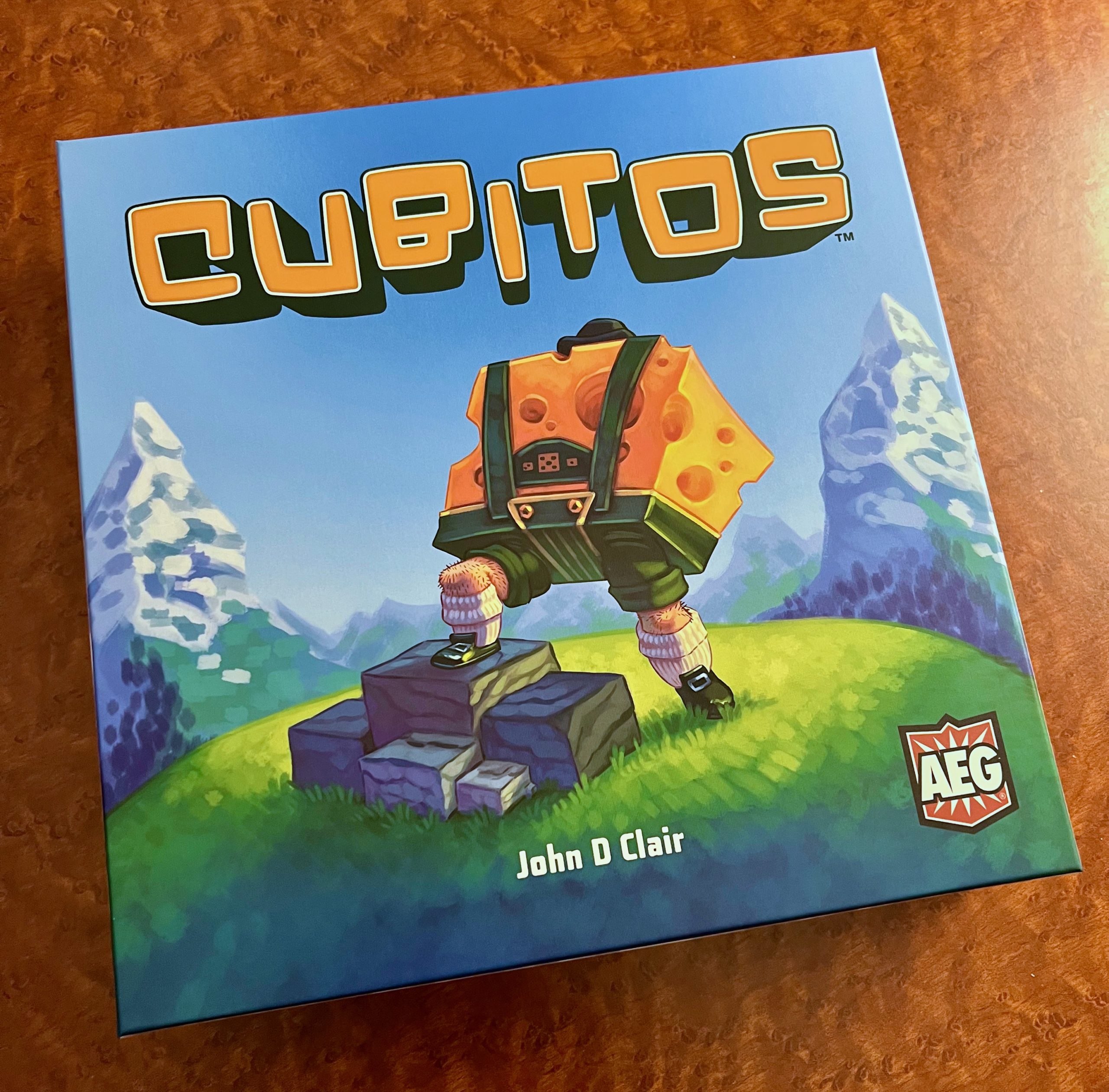
Cubitos was a lot of fun. Another good game if you like lots of dice. This is a game where you’re rolling dice to earn movement points, coins to buy more dice, and special abilities in order to move spots on a racetrack to beat the other players to the finish line.
You start with a bunch of basic dice, but the meat of the game is in buying dice that have special abilities. In addition to the basic dice, each game has eight colored dice. At the beginning of each game, you choose one card for each color of dice, and the card tells you what that color’s special ability is for that game. Some special abilities let you generate more coins or move farther, but there are lots of other, more interesting things too.
The push-your-luck dice rolling mechanic is interesting. You draw a certain number of dice from your pool, then roll all of them. If you get at least one non-blank face, you save it and then can choose whether to roll the blank ones again. If you ever roll all blank faces, you bust, and essentially end your turn.
Once you’ve decided to stop rolling, you proceed to the move phase, where you spend your movement going around the racetrack. There are lots of paths you can take, with obstacles, bonuses and other cool stuff. After you’ve moved, you can spend the coins to buy more of the colored dice, then you do it all again.
The components are mostly great. There are color-coordinated boxes for each of the sets of dice. They’re made to invert and serve as small trays/platforms for the dice during the game, which is nice, but they are a bit flimsy. Some plastic Chessex-type dice boxes would be great (but also more expensive). The art here is very good. There are four different racetracks in the game. The dice are a little small, but since you’re moving them around so much and rolling so many, I can see why they made that choice.
I had a lot of fun with this one, and I think the more the merrier with it, probably, especially since players take their roll phases simultaneously, then their move phases simultaneously. Unlike, say Tapestry, more players wouldn’t necessarily add a lot of time onto the game.
Imperial Settlers Roll & Write
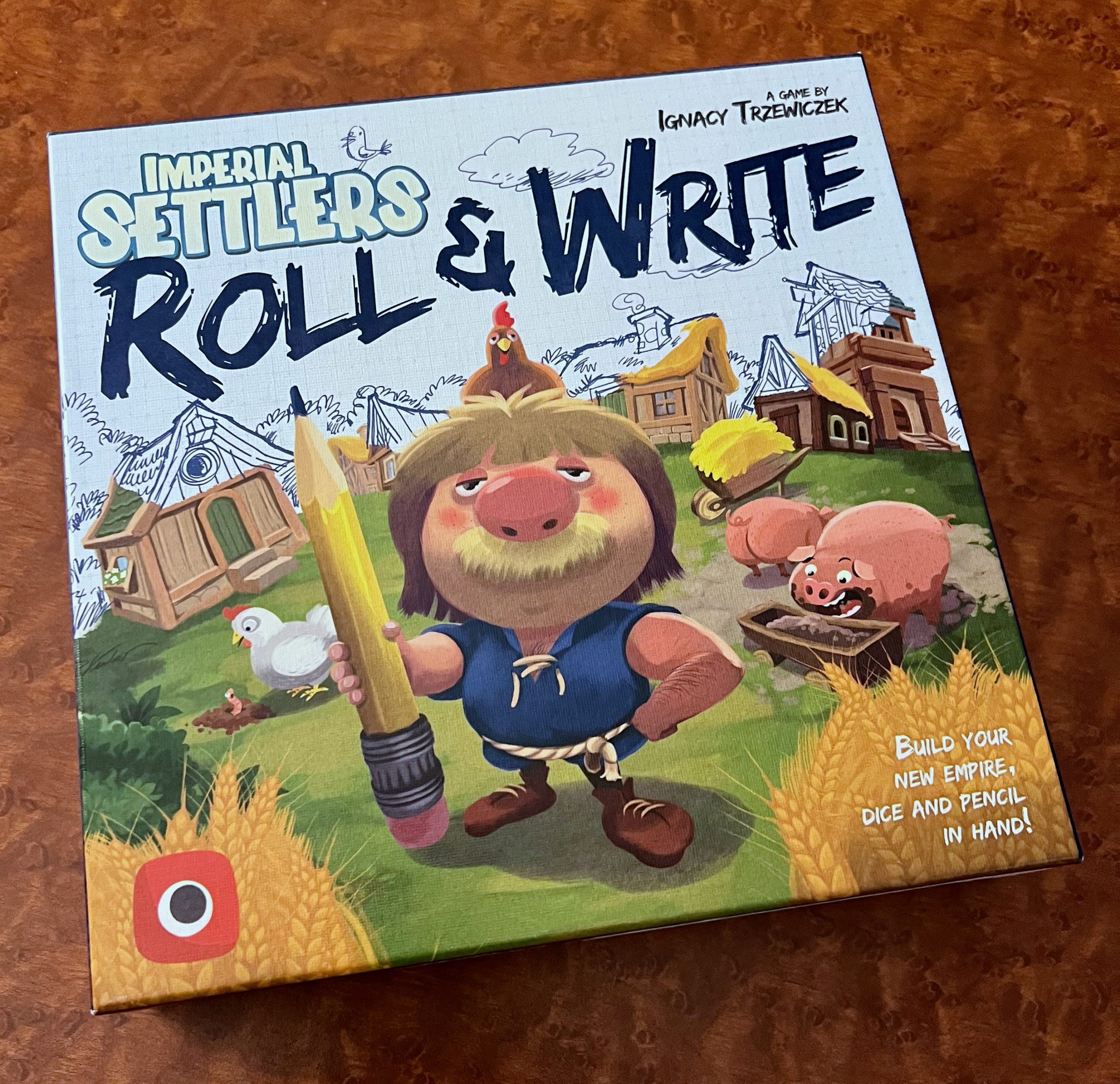
Imperial Settlers: Roll and Write is a, surprise, roll & write based on most efficiently using your workers (actions) and resources each turn. It is apparently based on another card game with which I am not familiar.
In the competitive mode, you and an opponent get a couple score sheets. You roll three resource dice to see what resources (wood, stone, food) are available this turn, and a worker die to see how many actions you can take. There are a few cards that provide bonuses for this turn, and each player takes one (ours were “1 extra worker”, “1 extra resource” and something I don’t remember because those were the only two anyone ever took).
Once you figure out the resources and actions available, you turn to your score sheets, and choose one square per action, as long as the resources are available. You eventually unlock fields where you can harvest additional resources, and construct buildings that give you certain abilities.
During the competitive game, both players are using the same score sheets — the only difference is in the bonus tiles you take in a round, and of course the choices you make throughout the game that unlock the abilities or extra resources that you can then use when your opponent perhaps cannot. There is a solo mode where each scoresheet is different to the last, providing some variety.
This one was just ok for me. Almost no player interaction, I didn’t think there was enough variety in what the buildings provided. If you really enjoy trying to maximize efficiency this one might have more appeal.
Parks

Now we’re talking. I’ve been looking forward to playing Parks for a while now, but haven’t had the chance.
Parks is a game about hiking through nature and visiting the national parks. You lay out a trail of different sites, and then, after figuring out the season’s weather pattern and making the according resources available on each site, each player moves two hikers down the trail.
Each site visited does something, usually gives you resources (water, sun, trees or mountains; there are also “wild” animal resources that are, well, wild). There are special sites that do other things. At the end of the trail, you can reserve a national park from one of the three face up or a face down one, you can visit one of the parks, including one you’ve previously reserved, or you can buy gear that gives you benefits. The parks provide points, there’s an occasional opportunity to take a photo for a point, and each player has a private goal.
You hike down the trail four times, each time adding one site to the trail, making it longer and longer, and changing the season.
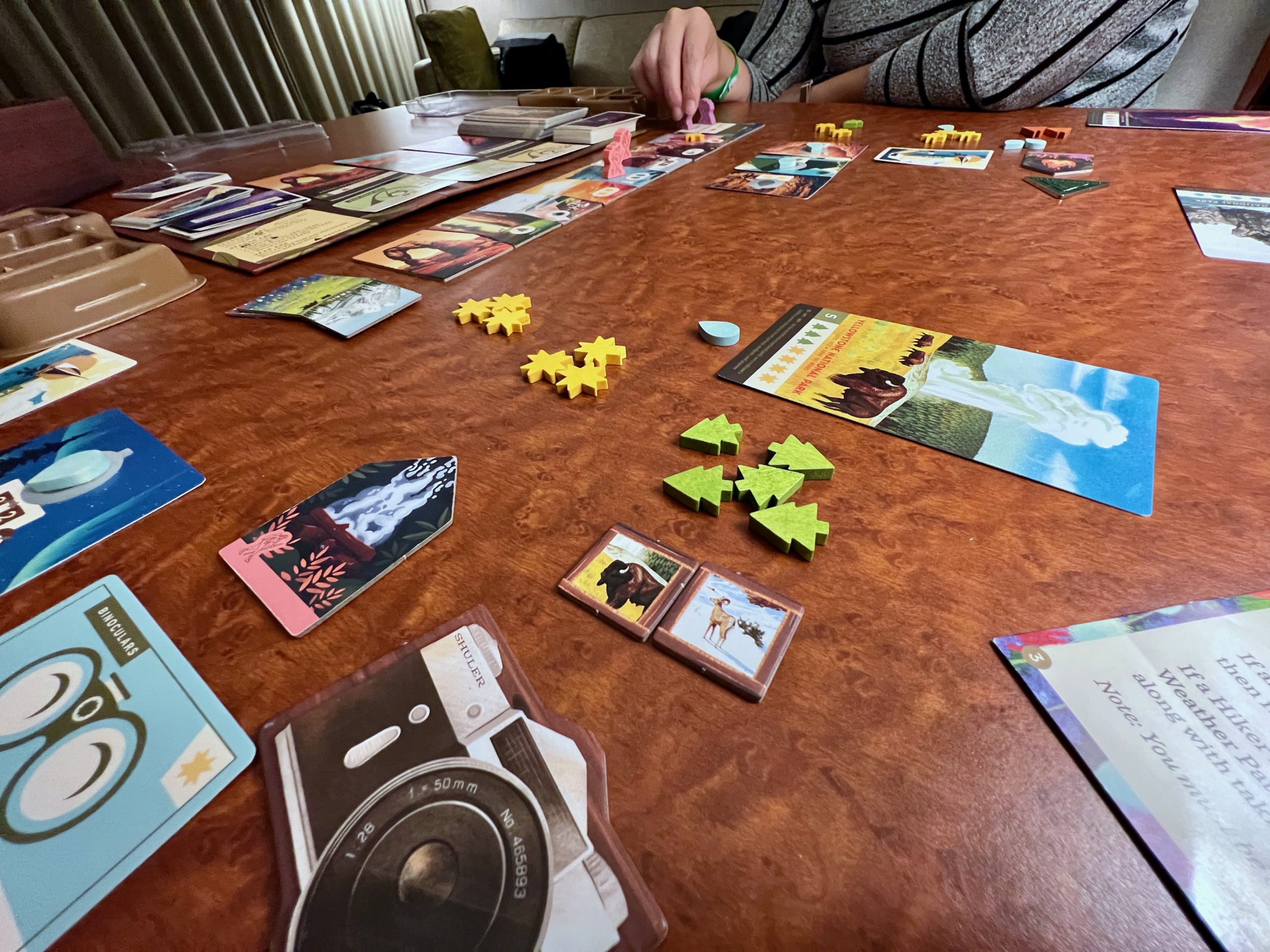
I enjoyed absolutely everything about this game. The turns were interesting. The player interaction (in addition to the other player getting your card first, there’s also getting to the end of the trail first to be first player back out next round, and occupying individual sites) was enough without being mean.
The components are great. The hikers, the resource tokens, the trail tiles. The first-player token is an enameled metal badge. There’s a large die-cut heavy cardboard camera tile that gets passed back and forth occasionally. The “wild” wild animal resource tokens are each a different animal. All great.
But the art is the star of the show here. The parks cards each have rich, lovely art for a different national park. And the game goes out of its way to credit the artist on each one, as well as in the instruction book (along with their website!). You almost can’t wait for the next parks card to come out just to see which park and the art on it.
The variety in the layout of the trail each season, the season card that changes the weather pattern, the gear and parks available, the individual goal, and the choices of your opponent would seem to make it pretty replayable, and there’s also a solo mode.
What a great game. It was also fitting that our very own local park managed to find its way onto the board during out game.

Geekway 2021: Day 2, Tuesday
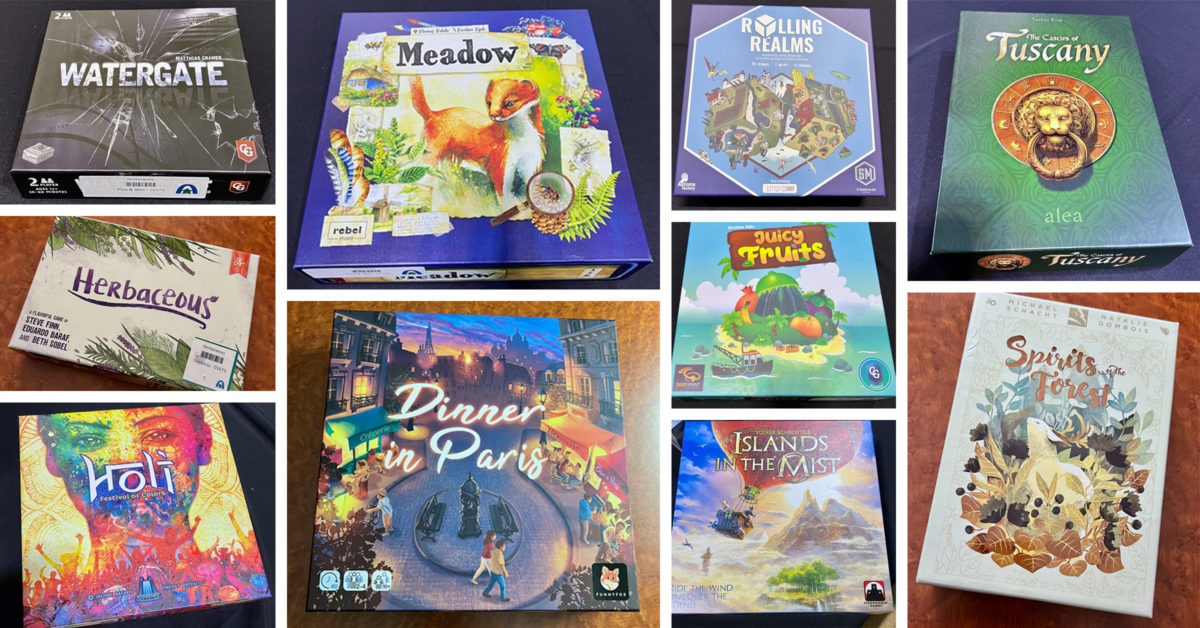
Tuesday was the first full day of Geekway, and we started off by playing 10, count ’em 10 games. Like all the games we played this year, they were all new to us for the year as well.
Unless otherwise noted, all these games were played at two players.
Rolling Realms
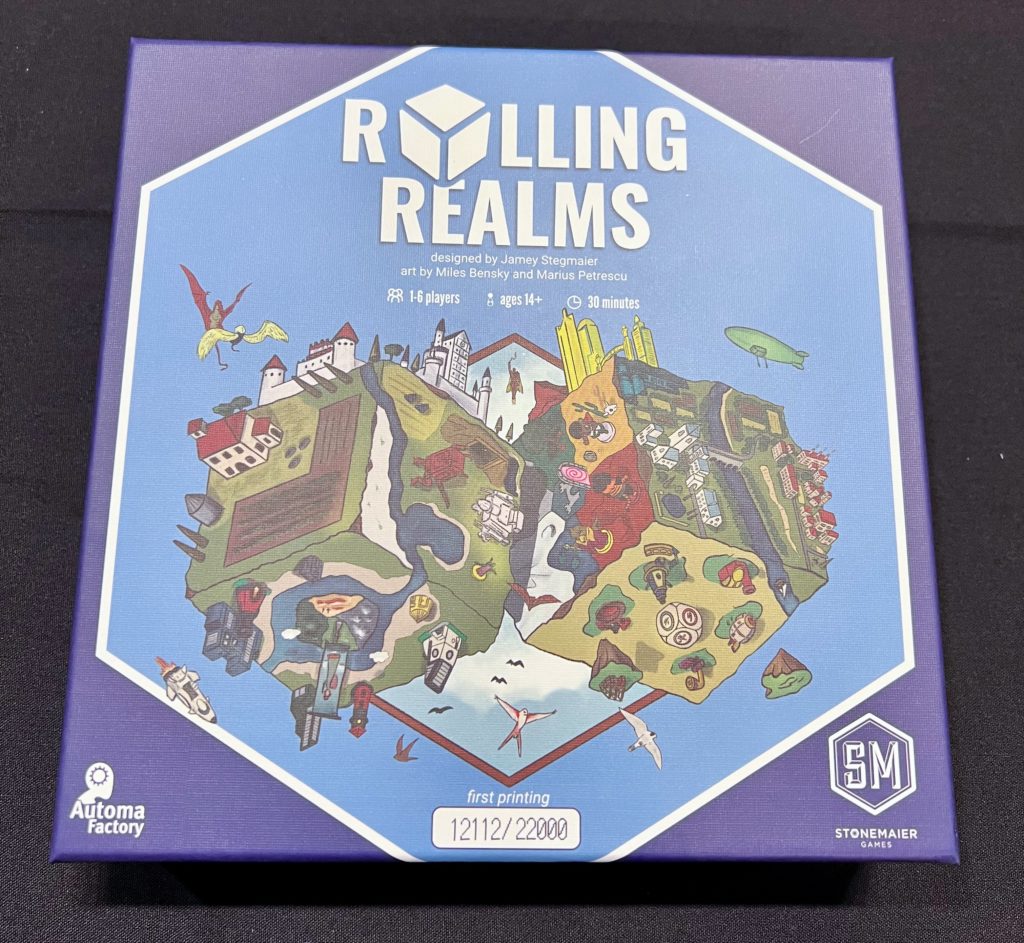
Rolling Realms is a new game by St. Louis’ own Jamey Stegmaier. It was developed during the pandemic to be something folks could easily play over Zoom or another live video-sharing service. As such, there’s literally no player interaction, so if that’s what you’re looking for, best skip this one. It’s also a roll-and-write, so if that isn’t your thing you might beware.
There are 11 different “minigames”, and you’re playing three simultaneously in each of three rounds (a different set of three per round). Each minigame is based on another Stonemaier game, and of the games I’ve played I did recognize the connection.
You’d think a game based on dice rolls is heavily luck dependent, but since you and anyone you’re playing with is using the same roll, the competition is in the choices you make with the rolls, not the luck of the dice. Additionally, there are mechanics to spend resources to modify the dice rolls, gain extra dice, etc., so there are choices involved there as well.
I liked it. It played relatively fast. Realizing the connections to the other games was neat. Although there was no player interaction, there were enough choices to make that it felt interesting. And the glimpses I caught of the “minigolf” solo mode looked fun as well.
Juicy Fruits
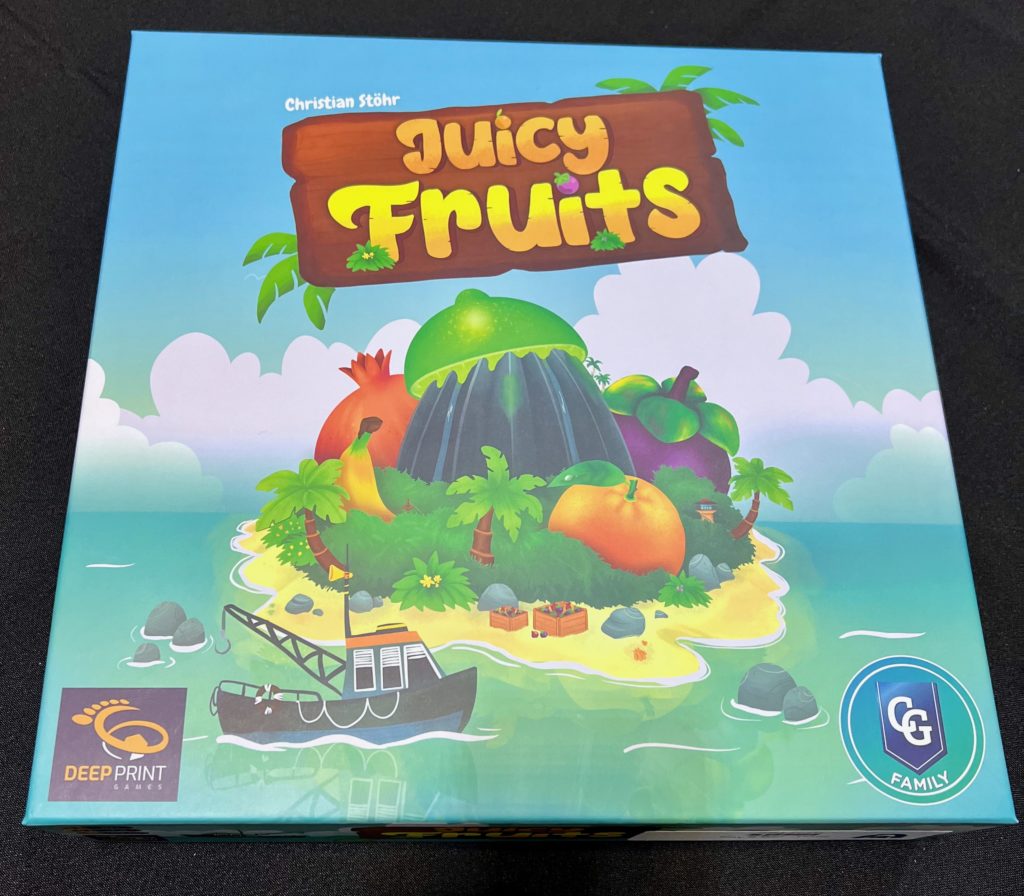
Loved the box on Juicy Fruits. The game has an interesting move mechanic where you have a gridded board with stuff on it, and you earn resources based on sliding things around in straight lines, and how far you can slide them before reaching the edge of the board or bumping anything else.
The art on the inside of the box was fine. The components were well-constructed. You had boards and cardboard tiles, but also pretty chunky wooden fruit resources in vivid colors. Fun to look at and handle.
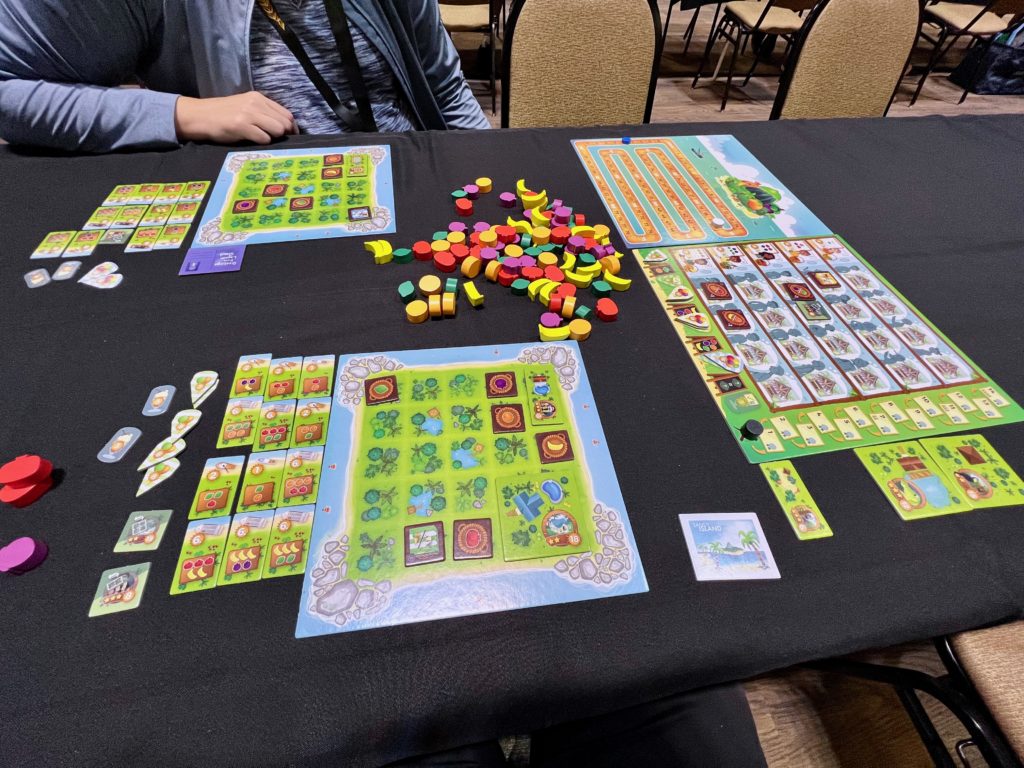
I didn’t find this one extremely compelling — it wasn’t uninteresting or bad, just ok. Though the setup makes it different each time, the overall strategy, particularly in the early game, seems pretty straightforward. There’s also little player interaction — you’re competing for the same pool of things to buy later in the game, and whoever gets there first gets to buy, but that’s about it.
There is a solo mode for this one too, but I didn’t look at it enough to tell how it works. Seems like it might be a bit different because some of the pieces were labeled in a way that was interesting but not used at all for our game.
Meadow
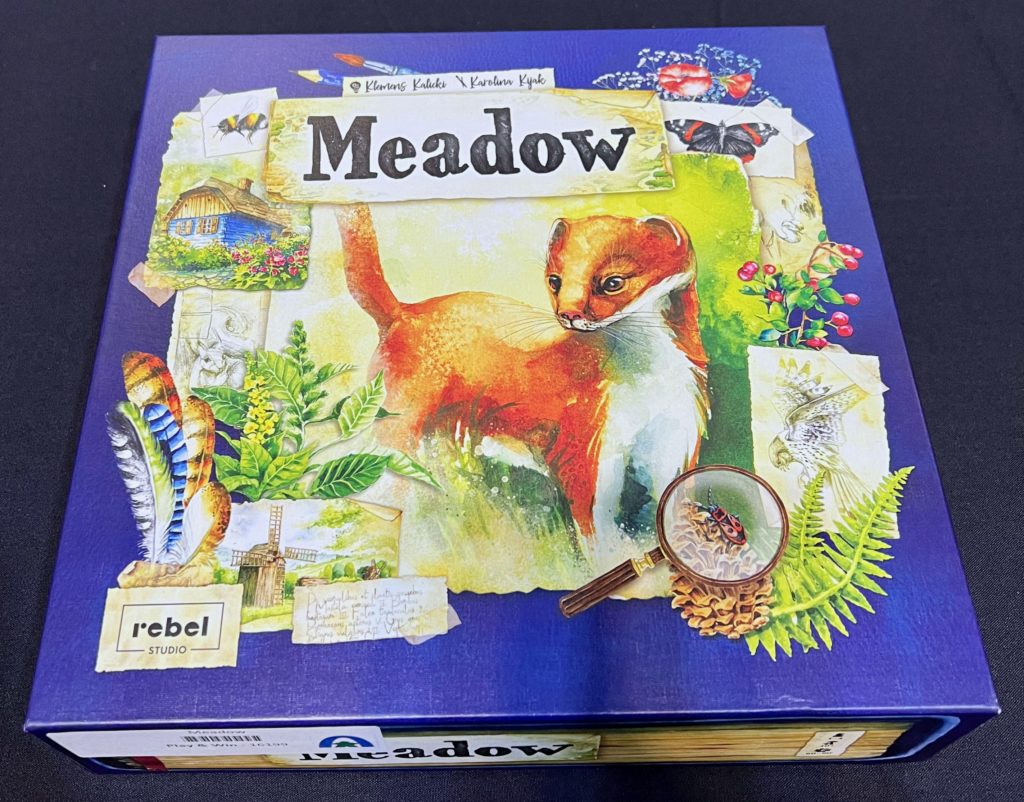
Meadow. I was really impressed by this one. This time, we played it at three players — I’d started setting it up while my wife was elsewhere, and someone stopped by the table to ask if I was looking for someone to play with. He said he’d played it solo but didn’t know how it would go with more. I said sure, he was welcome to play. Also helpful because he knew the setup and how to play.
The game is about collecting sets of cards with compatible symbols. There are various ways to collect the cards, which is this game’s player interaction, mostly — getting a card before someone else, as well as the mechanic for choosing the card having the potential to block others off. There are also some special actions you can take, and that number is limited for all players for the whole round (e.g. 4 opportunities per round for our 3-player game, so if everyone takes one, only one person gets a second one).
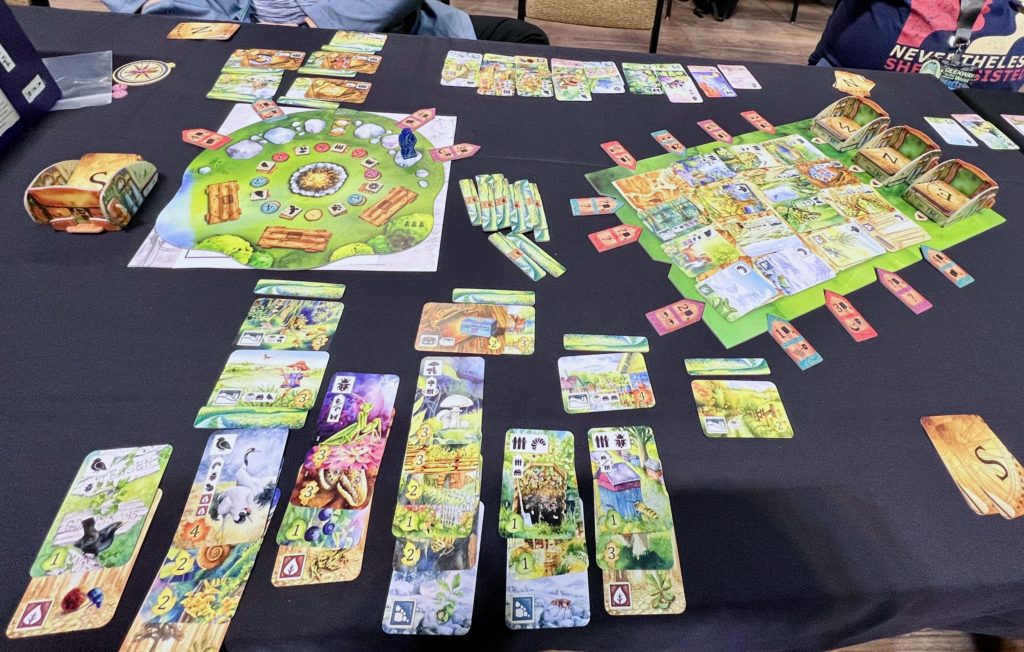
Thematically, you’re hiking through a meadow and exploring, and the cards you take represent things you see along the way. The cards and symbols represent this theme well — there are “ground cards” representing different types of terrain (woods, rocks, hills, wetlands, etc.), and you build on top of those with other things, trees, bugs, grubs, etc. There’s a card, for example, that requires you have already played a grub, and the card itself is a butterfly. Makes sense.
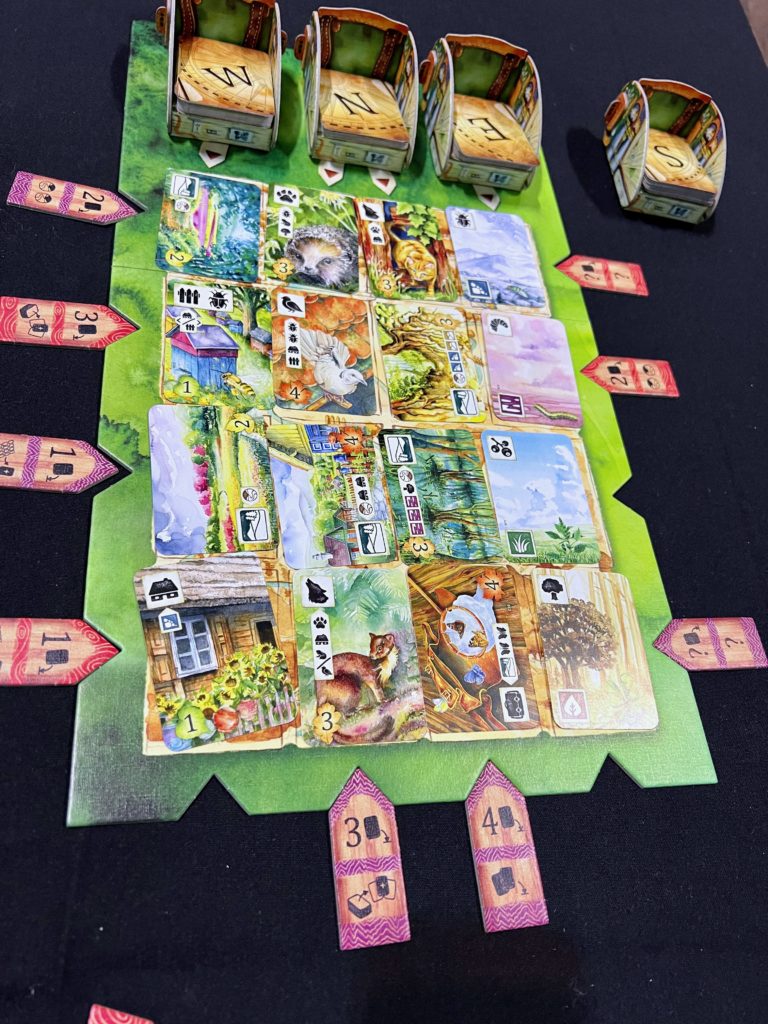
The thing about this game is the artwork. 200+ cards with watercolor-style illustrations, and they’re all unique. The game also includes some special envelopes with a few cards themed together to use. The included index with all the card details spoils these, but I won’t here. They’re a great idea and I’d be excited to play with them.
Gameplay was good. It worked very well at three players. This one’s definitely on a list for purchase/gift.
Watergate
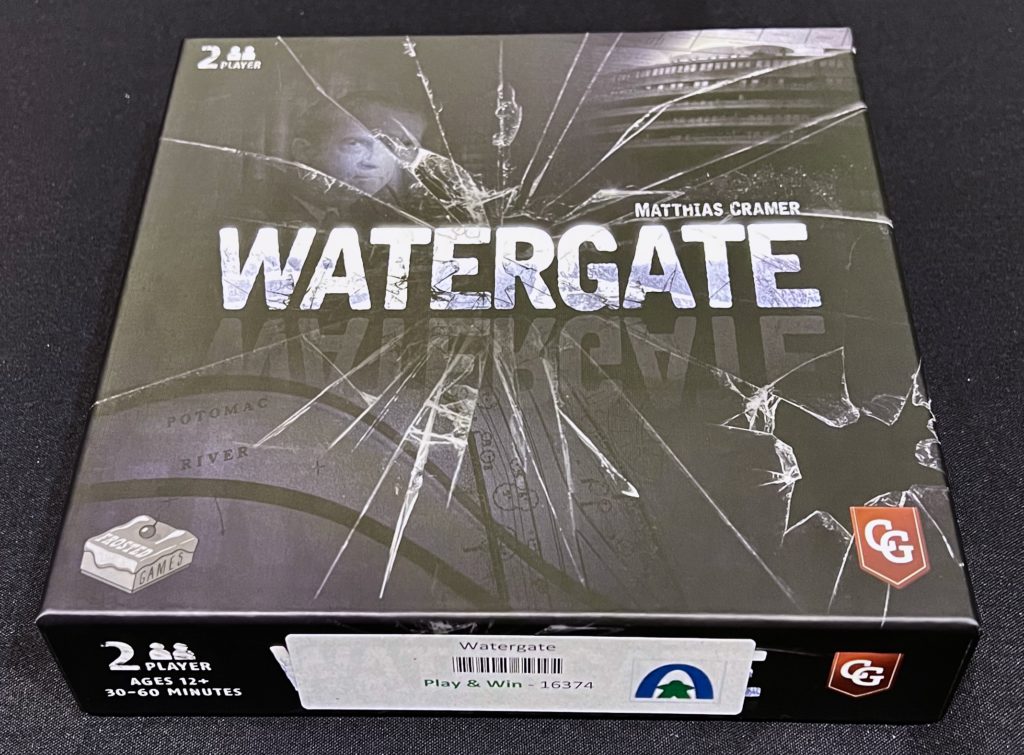
Watergate, as you might guess, is themed around the Watergate Scandal resulting in the resignation of Richard Nixon. It’s a 2-player asymmetric game where one player plays “a newspaper editor” (read: Ben Bradlee) and another player plays “the Nixon Administration” (read: Nixon).
This one might have too much player interaction for me, in that you’re playing cards back and forth to have a sort of tug-of-war over influence, momentum and evidence. There are differing win conditions too.
The editor tries to connect Nixon to two informants with evidence. There’s a triangle-pattern corkboard (think the corkboard with pinned up evidence and red thread connecting them cliché) with prominent individuals from the investigation around the edge. The editor wants to obtain enough evidence to make paths from two of these people to Nixon, who is in the center.
Nixon, meanwhile, is trying to block the editor’s paths to prevent him from winning. But Nixon’s win condition is to either gain momentum (thematically, to be politically powerful), or at least to wait the editor out.
The game is well done. The corkboard is, as I said, a bit cliché, but fine. The cards represent different people and events from the time, and marry the theme and gameplay pretty well.
It’s not really for us, being a direct-conflict, take-that type of thing, but I can see its appeal and it works well mechanically and thematically.
Castles of Tuscany

The Castles of Tuscany looked complicated but turned out to be not bad. We met up with a couple friends for this one, so we played this at 4. I think it also would have worked fine at 2.
The idea behind this is that you’re expanding your region in Tuscany during the Italian Renaissance. You build castles, agriculture, transportation routes, villages and other stuff to earn points and extend your region.
Each player has three hexagonal starting boards, which you can arrange in a bunch of different ways, so your setup can be different for each game. You’ll be playing on your own board throughout the game by choosing face-up tiles from a community supply, so the player interaction is mostly taking a desired tile first. There’s also a first-player bonus for completing colored regions.
Reading the rules I was concerned there might be a little too much going on in this one, but once we got going it was pretty smooth. There were a couple rules interpretation issues we had — I now see there’s an unofficial FAQ clarifying some translation ambiguities, including the main question we had (about the agriculture scoring) and something we just got wrong (about the marble/worker capacity limits). Our mistakes weren’t game-breaking though, so it was still a good time.

Components were fine. Lots of cardboard tiles and hexes. The hex boards had a nice blending of colors around the regions to make them flow into each other.
I also didn’t grasp the score mechanic until too late — you earn points during each of three rounds on the outer green ring of the score track, then at the end of each round, your score is transferred to the inner red ring, but the green ring doesn’t reset. The effect of this is something of a runaway leader problem, but a more charitable interpretation is that points earned in the first round are worth 3x points scored in the third round (because first round points essentially count again in the second and third rounds). Ah well.
Once we got going, I liked this one ok. Probably a few too many bits to get to our table on a regular basis, but definitely one I wouldn’t mind playing again.
Dinner in Paris
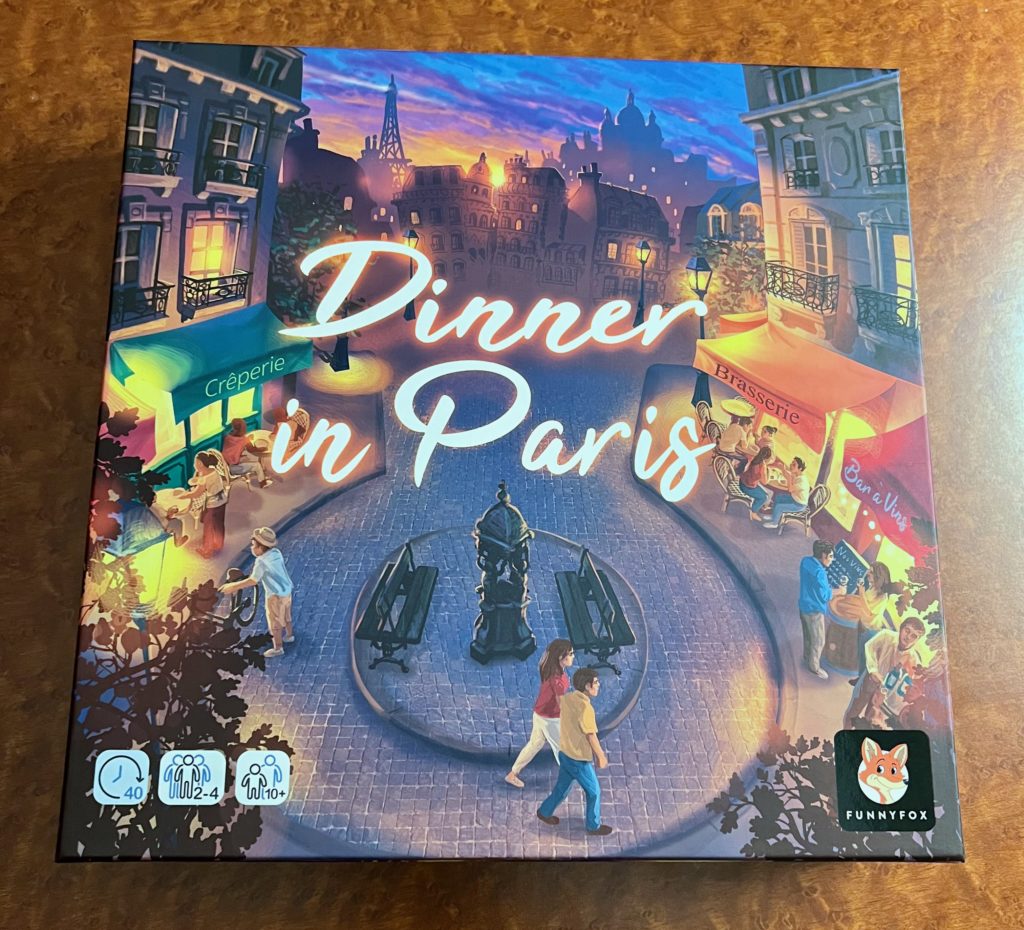
Dinner in Paris has you drawing cards to collect sets to build restaurants to earn money to build terraces to collect victory points and complete objectives. Got that?
There’s a square in Paris that, astonishingly, doesn’t have any restaurants built on it yet. This is the board, divided into small squares and covered with typical plaza-type features like streetlights, fountains, flowerbeds, pigeons and a band. You draw cards featuring one or more ingredients (potatoes, flour, tomatoes, a crab, etc.). If you have the right combination of ingredients, you can open a restaurant on the edge of the square. You then pay money to build terraces for your restaurants across the plaza. The more terrace you build, the more your restaurant earns, both in money (to build more terrace) and victory points.
I liked this one. There are four restaurant sizes you can build, and except for the smallest size, at least two combinations that let you build different restaurants (apart from paying different ingredients, the different restaurants of the same size don’t have any effect on gameplay, except for maybe end-game bonus conditions). The different sizes of restaurants, appropriately, provide different benefits and cost different amounts to add terraces to.
Building the terraces can be challenging — both physically, as the player boards have little indentations for the terraces to sit nicely, but sometimes difficult to get out easily, and conceptually, because there are a few rules to follow when placing them (chiefly, two restaurants’ terraces can’t touch orthogonally — most of the time).
For victory points, you largely get them based on terraces built. Also, there are three community objectives with ranked scoring, and then private objectives you can complete throughout the game.

The components here were very nice. Artwork on the board and cards is well done. The buildings are good-sized 3D plastic models. As I mentioned the player boards have indentations for the terraces which, while sometimes making it tricky to remove them, is great for organization.
Lots of bits to this one, but nice to look at and nice to play.
Islands in the Mist
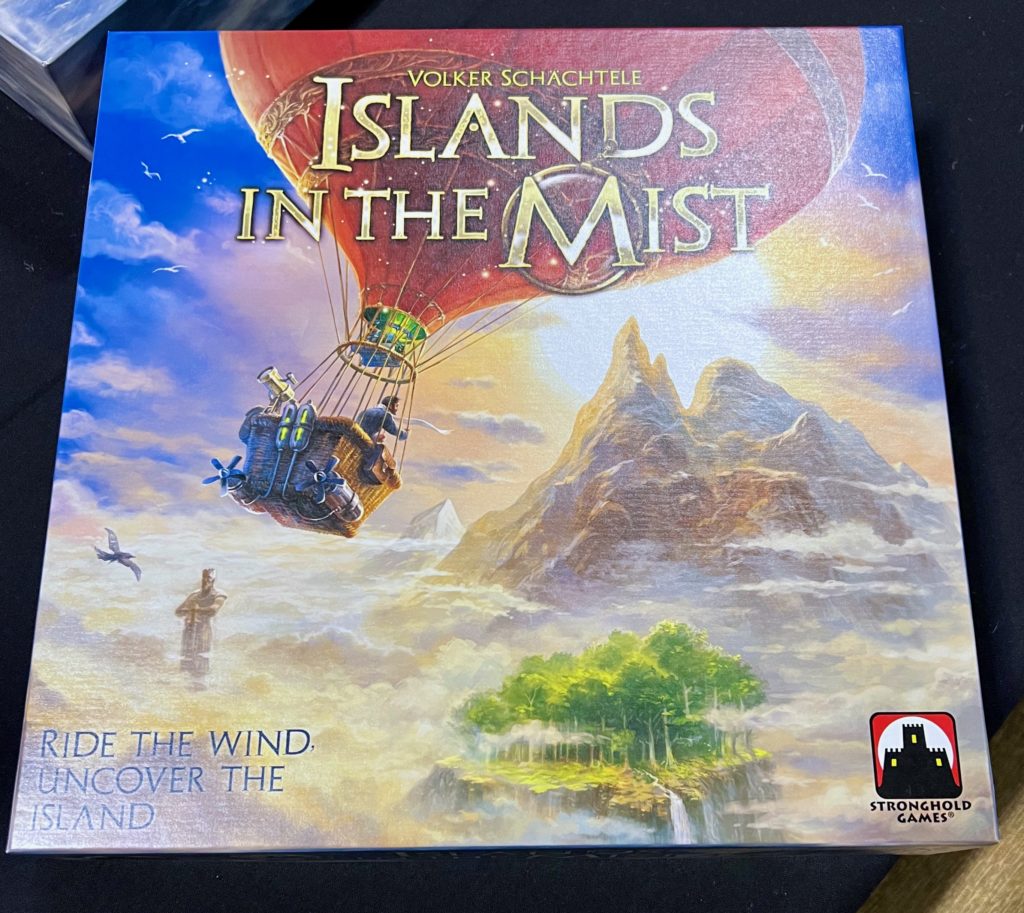
If the box didn’t tip you off, Islands in the Mist is hot air balloons. This one has nice art and components and an interesting move mechanic.
You’re an explorer in a hot air balloon taking off from the city in the center of the island to map what you can find. You earn points for finding routes to each coast, as well as large areas of the same terrain, other cities and monuments, and covering the volcanoes that start your board with negative points.
This game is all about the move mechanic, and taking advantage of it. The second player rolls the dice, one of which has a direction and the other has several bonus modifiers. That player can choose to reroll one or both dice one time. Then both players use that roll. Speed is determined by the number of the hex space you’re currently on (each player’s speed is independent, but the same direction is used for both). You can speed up or slow down, or move in a different direction on a turn (always moving in a straight line), but it costs you energy, which is a limited resource. The bonus die also can, depending on how it lands, let you travel either opposite to the wind or at an angle to it.
Once you’ve moved, you then choose from several tile options, and can keep a limited number of them or turn them into energy. These represent the terrain you’re discovering and generally, you want to connect same terrain to same terrain (each coast is a different terrain type, while the middle of the board starts out as all fog). The terrain tiles also have speed numbers on them, so there’s some strategy in planning a route even if you don’t know which way the wind will blow on your next turn.
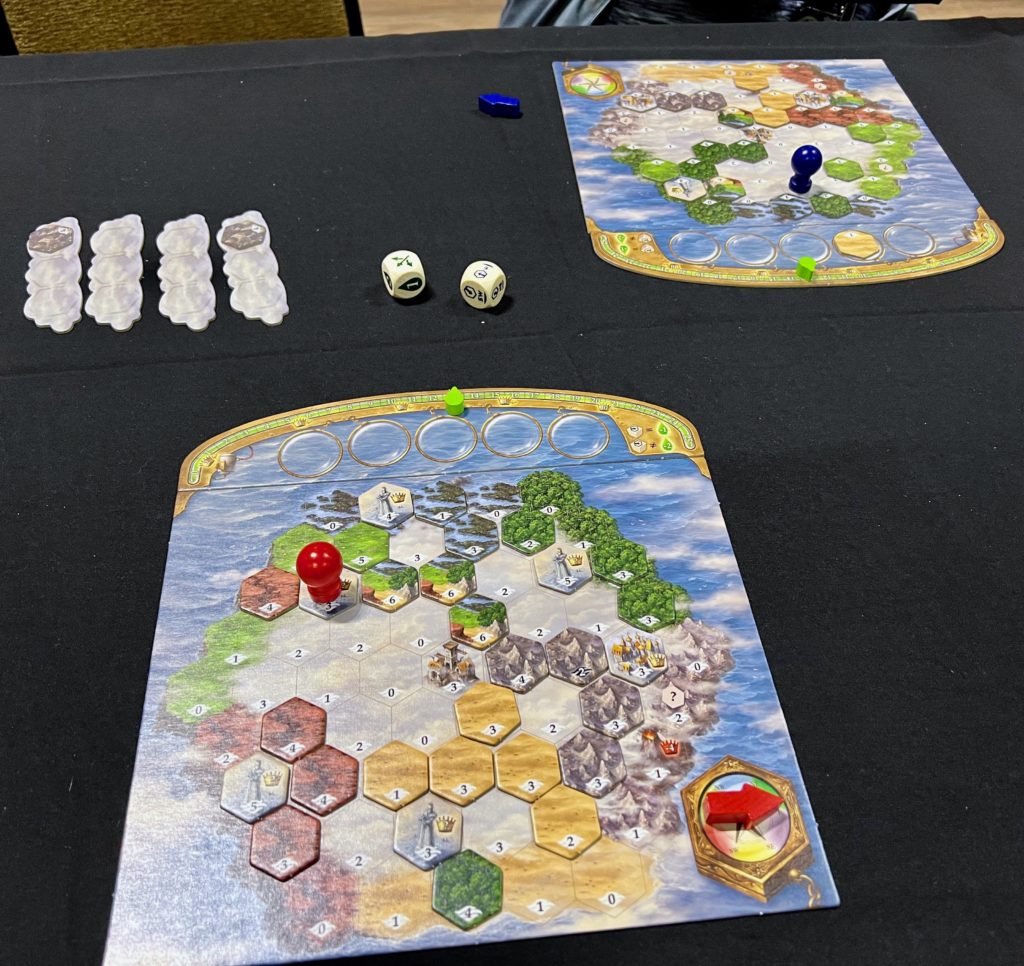
The art is nicely themed. Could maybe have used a little more variation on the tiles, but what’s there is nice, especially the player boards. The components are big and chunky. I especially liked the dice, which are large, with foil-stamped symbols in green and blue.
There were also a couple add-ons to this game in the box, but we just played the base game. I liked it. The player interaction is in the rolling dice and choosing whether or not to reroll, as well as in choosing the tiles. Not a lot, but enough for me. I’d be interested in exploring the add-ons, but I had a good time with even the base game.
Holi: Festival of Colors
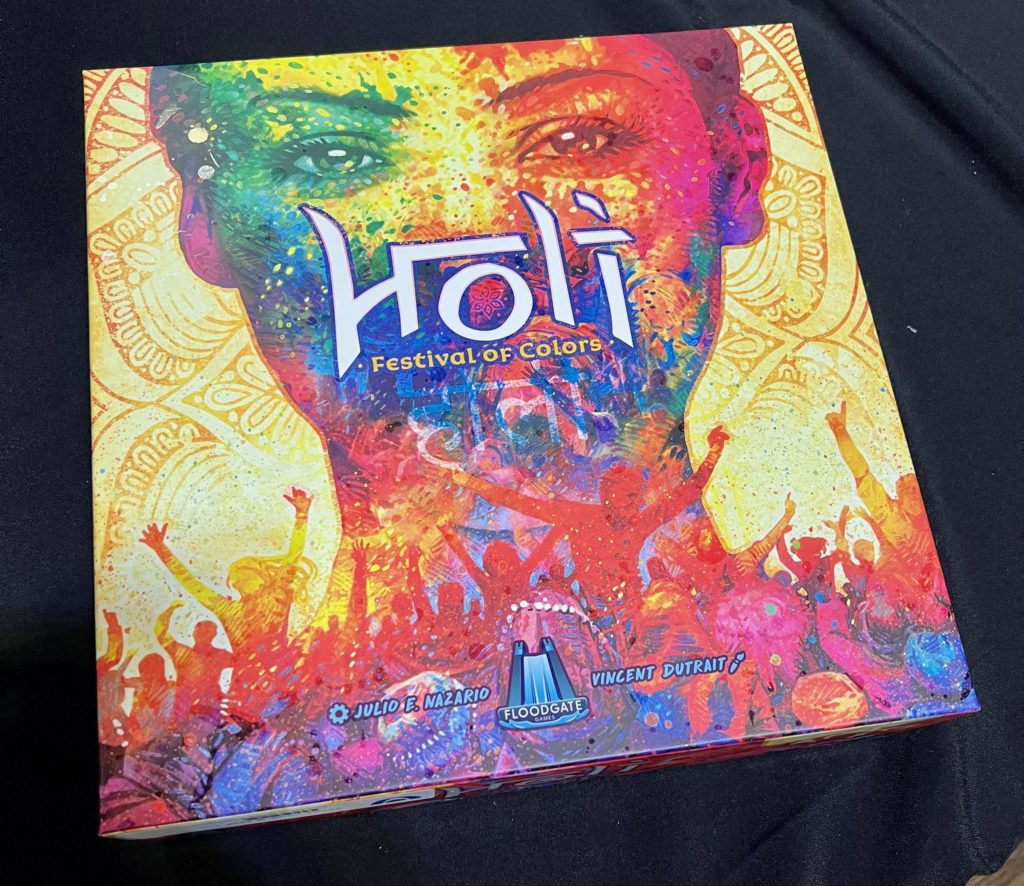
Holi: Festival of Colors is themed around the Indian celebration. It features a tall 3D playing surface with three levels, and things potentially happening on all three levels at once.
In Holi, you have a limited supply of colors and your goal is to spread as much color around as possible, as well as to hit your opponent with color. You do this by moving around the boards and playing cards with patterns on them showing how you can spread your color that turn. There are bonus points for hitting your opponent, or picking up the sweets that are scattered around the board at the beginning of the game.
Once several colors are placed, players have the option to climb to a higher board (but you can’t go back down). Once you’re on an upper board, throwing your color might cause them to fall to a lower board or onto an opponent if they haven’t climbed up yet. Colors that stay on higher levels are worth more points at the end of the game.

This one looks fantastic on the table, tall and with bright colors almost suspended in air. It would be even more colorful with four players. The player tokens are large, wooden and printed colorfully. The color tokens are cardboard and different shapes as well as colors, which is a nice touch. The tower corners are heavy cardboard with great art. The plastic levels have indentations to keep players, colors and sweets in their place, while their borders are nicely printed and have coordinates to make placing falling colors easy. My only minor quibble might be the plastic boards are a little flimsy, but I recognize it’s a tradeoff between heft and weight there. Still, it really stands out.
This one is definitely direct player interaction, but it doesn’t feel mean-spirited. You’re not even hurting the other player, so much as earning points for yourself by hitting them. There are also “Rivalry Cards” that have lots of options for modifying the rules or scoring during a game for more replayability.
This one was fun, quick, and with more strategy than it seems at first glance. We also won it from the play-and-win contest at Geekway, so I’m sure we’ll be enjoying it more in the future.
Herbaceous
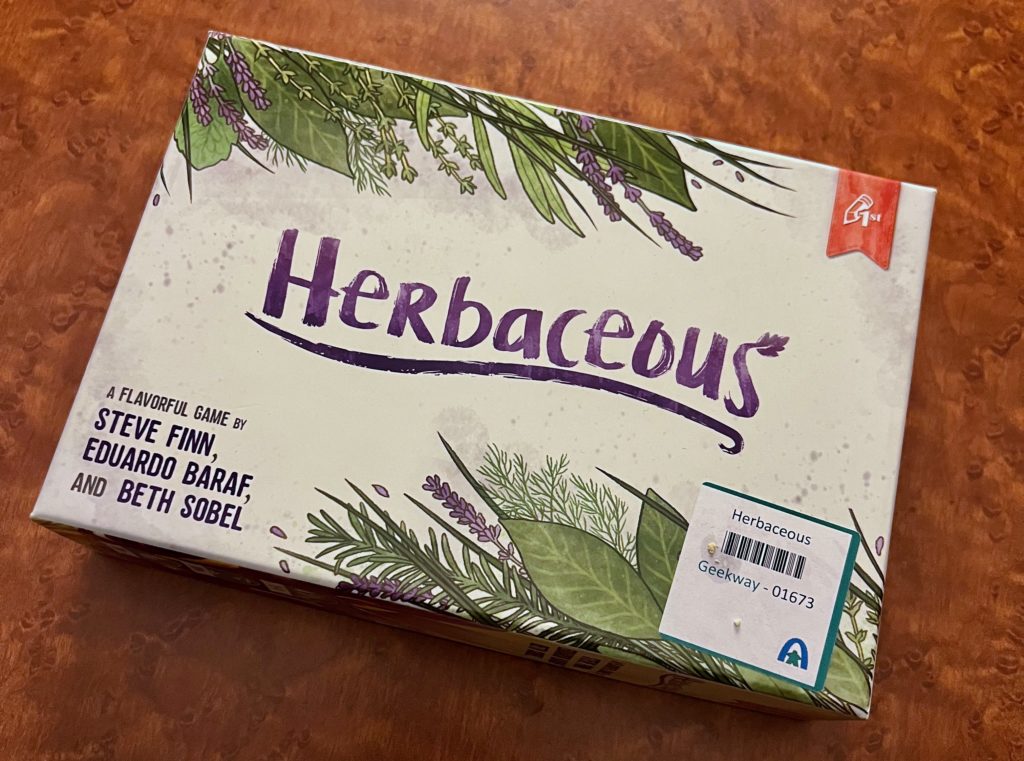
Herbaceous is a quick set-collection card game themed around planting herbs, then repotting them in various combinations.
Each turn, you draw a card which will be one of seven different types of herbs, or one of three special herbs, and plant it either in your private garden or the community garden. Then you draw another card and plant it in the other garden.
On subsequent turns — prior to planting — you can choose to pot herbs that have been planted. You have four different containers representing different types of sets: One where herbs must be all different. One where herbs must be all the same. One where you have to plant herbs in pairs different to each other. And one where you can plant any three herbs. This last one is the only place where the special herbs can be planted, and they earn a bonus for being planted there.
And that’s pretty much it. With two players it’s pretty back-and-forth. I bet it would be very different with four, since there’s more of a risk someone else will pot what you’re hoping to pot before it gets to being your turn again. The cards and art are nice. It’s a pretty quick, light game. Doesn’t require a ton of thinking, and that’s ok. I enjoyed it.
Spirits of the Forest

Spirits of the Forest is a set-collection/drafting game with reservation. Thematically, you’re collecting spirits and elements from the forest, attempting to gather more than your opponents.
The game is set up with 48 colorful tiles laid out in four rows. These are “suited” — each color represents one of nine spirits — and feature one or two icons of that spirit. The suits aren’t the same though, there are different numbers of tiles and different numbers of total icons in each suit. Each tile helpfully has a large number on it to remind you how many total icons of that suit are available. If a tile has only one suit icon, it might also have the icon of one of three types of power sources (sun, moon, fire).
Additionally, there are 14 tokens with symbols, of which you randomly place eight, face down, on the tiles. The symbols are mostly additional suit or power source symbols.
Players alternate choosing one or two tiles, but only from the ends of any row. If you take a tile with two suit icons, you only get one tile. Alternately, you can take two tiles of the same suit, if they both only have one suit icon. If a tile has a token on it, you get that as a bonus icon (and it’s hidden from the opponent until the end of the game).
Players can also use one of two gems (or three, in a four-player game) to quasi-reserve tiles. If you take a tile you’ve reserved, you get your gem back. You can take a tile someone else has reserved, but you lose one of your gems. Some of the bonus tokens, instead of an icon, allow you to recover a gem you’ve lost this way.
At the end of the game, players figure out who has the most icons of each type (including both tiles and bonus tokens), and only the player with the most scores points equal to how many they had. If you don’t have any of a given type, you get a penalty.
The components and art on this one are very nice. The title on the box is gold foil, and the colors throughout are rich — though some of the colors are probably a bit too close together. The illustrations have a style that appeals to me.
The gameplay at two was fine. There’s more depth than meets the eye at first, especially when judiciously using and losing your gems. I think it would be much better at three or four players.
Day 2 conclusion
We learned ten games on Tuesday, and it was exhausting. Meadow was definitely the standout for me, but there weren’t any complete duds and several are on the “I’d like to play this again sometime” list.
Read Day 1 | Day 3 | Day 4 | Wrapup